Talent Management: Importance, Strategy and Practices
VerifiedAdded on 2022/11/19
|19
|4960
|62
AI Summary
This report discusses the importance of talent management strategy and practices for organizational operations. It outlines a brief discussion on talent management for a US based hospitality company that has decided to open 2 boutique hotels in Singapore in 2020. The report focuses on developing a proper talent management policy for organizational operations with detailed discussion on carrying out several HR practices in the talent management strategy.
Contribute Materials
Your contribution can guide someone’s learning journey. Share your
documents today.
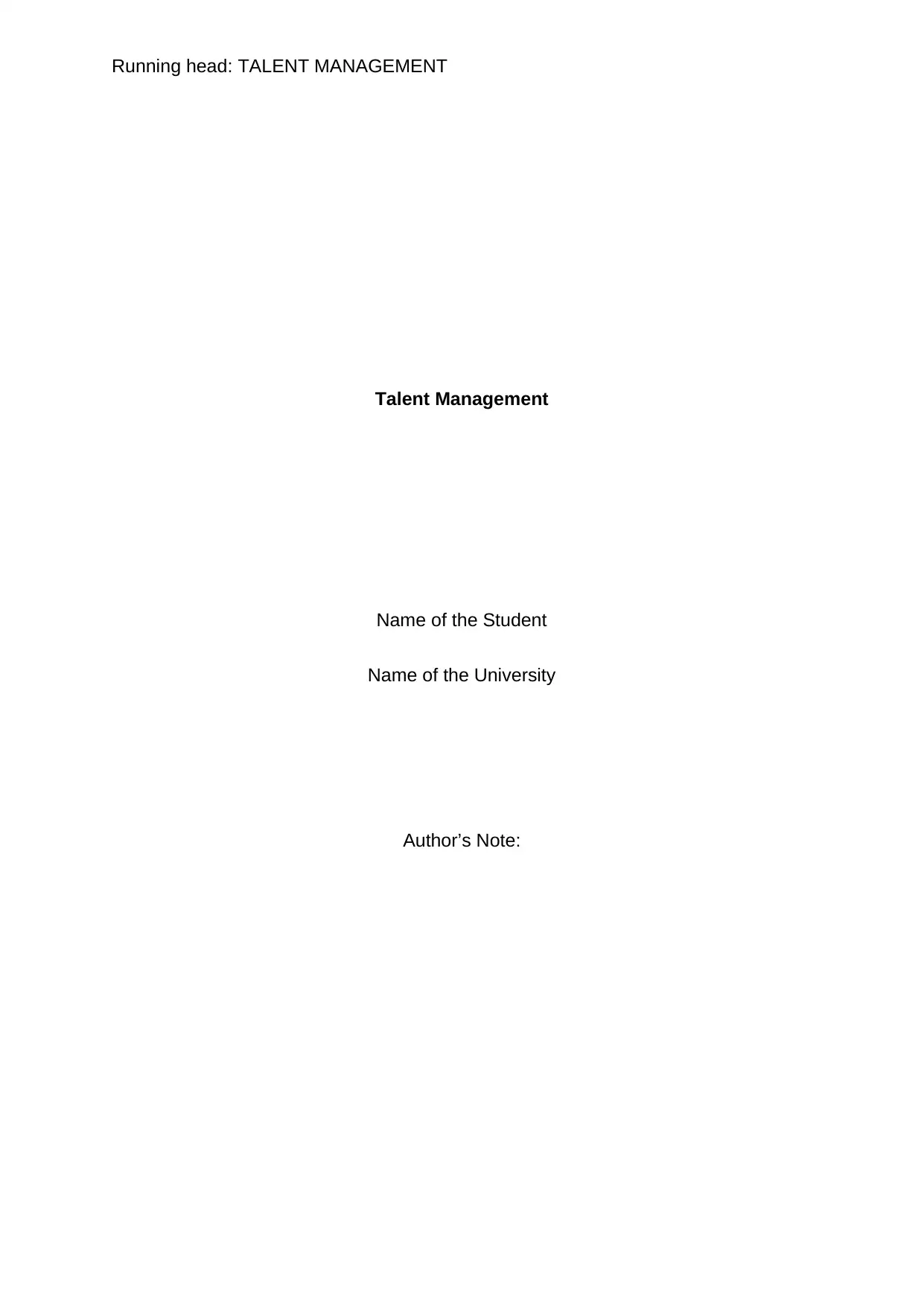
Running head: TALENT MANAGEMENT
Talent Management
Name of the Student
Name of the University
Author’s Note:
Talent Management
Name of the Student
Name of the University
Author’s Note:
Secure Best Marks with AI Grader
Need help grading? Try our AI Grader for instant feedback on your assignments.
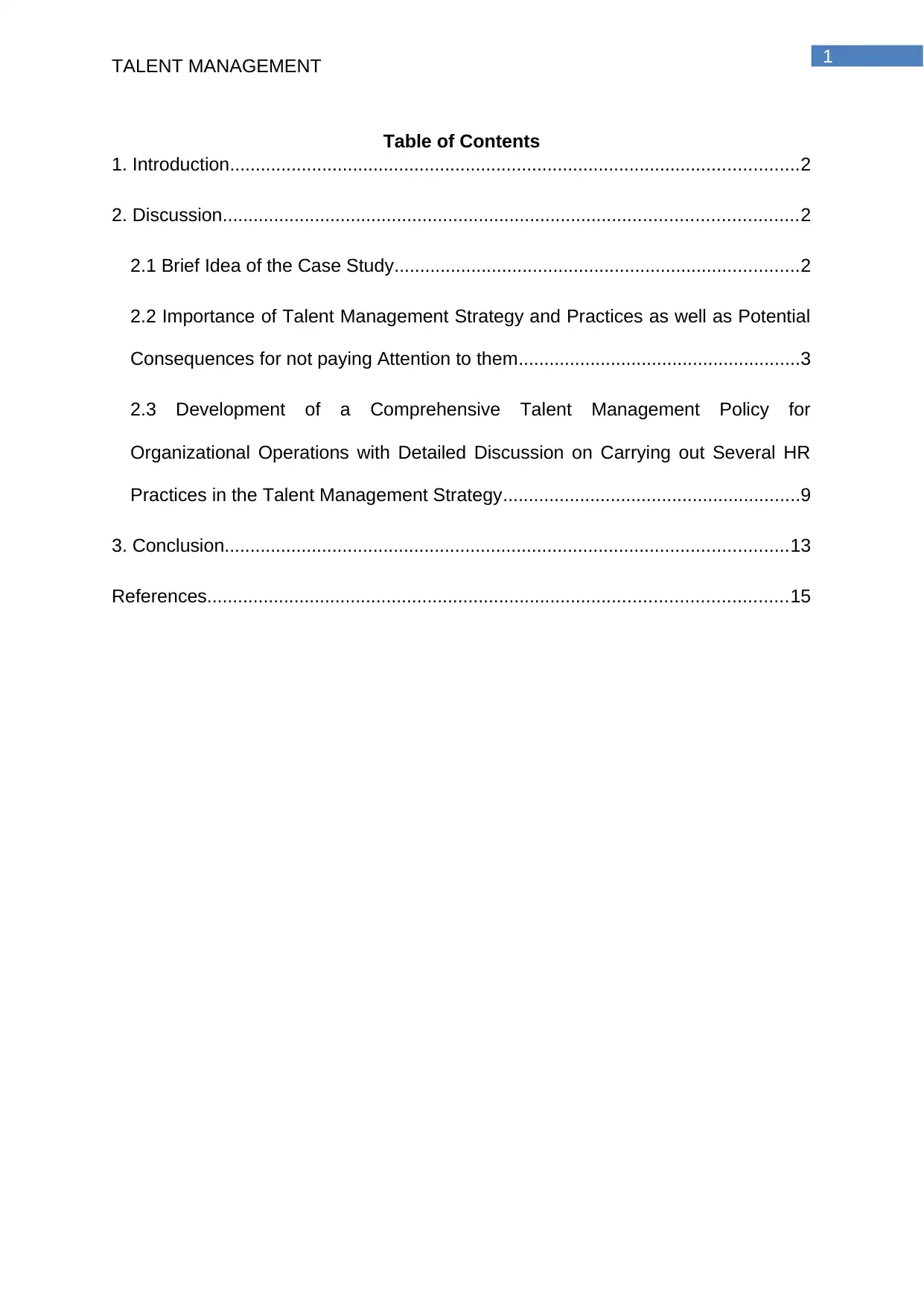
1
TALENT MANAGEMENT
Table of Contents
1. Introduction...............................................................................................................2
2. Discussion................................................................................................................2
2.1 Brief Idea of the Case Study...............................................................................2
2.2 Importance of Talent Management Strategy and Practices as well as Potential
Consequences for not paying Attention to them.......................................................3
2.3 Development of a Comprehensive Talent Management Policy for
Organizational Operations with Detailed Discussion on Carrying out Several HR
Practices in the Talent Management Strategy..........................................................9
3. Conclusion..............................................................................................................13
References.................................................................................................................15
TALENT MANAGEMENT
Table of Contents
1. Introduction...............................................................................................................2
2. Discussion................................................................................................................2
2.1 Brief Idea of the Case Study...............................................................................2
2.2 Importance of Talent Management Strategy and Practices as well as Potential
Consequences for not paying Attention to them.......................................................3
2.3 Development of a Comprehensive Talent Management Policy for
Organizational Operations with Detailed Discussion on Carrying out Several HR
Practices in the Talent Management Strategy..........................................................9
3. Conclusion..............................................................................................................13
References.................................................................................................................15
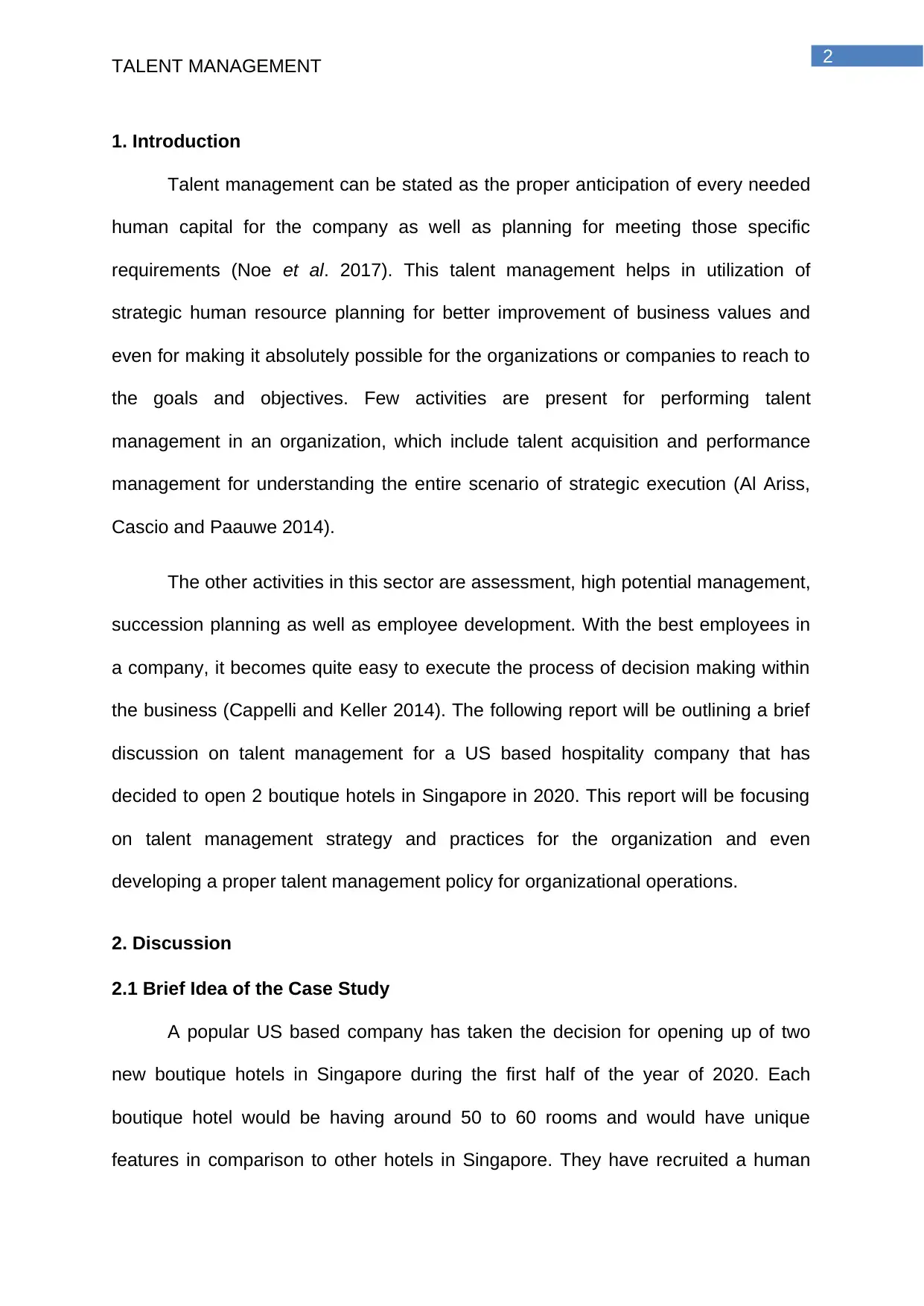
2
TALENT MANAGEMENT
1. Introduction
Talent management can be stated as the proper anticipation of every needed
human capital for the company as well as planning for meeting those specific
requirements (Noe et al. 2017). This talent management helps in utilization of
strategic human resource planning for better improvement of business values and
even for making it absolutely possible for the organizations or companies to reach to
the goals and objectives. Few activities are present for performing talent
management in an organization, which include talent acquisition and performance
management for understanding the entire scenario of strategic execution (Al Ariss,
Cascio and Paauwe 2014).
The other activities in this sector are assessment, high potential management,
succession planning as well as employee development. With the best employees in
a company, it becomes quite easy to execute the process of decision making within
the business (Cappelli and Keller 2014). The following report will be outlining a brief
discussion on talent management for a US based hospitality company that has
decided to open 2 boutique hotels in Singapore in 2020. This report will be focusing
on talent management strategy and practices for the organization and even
developing a proper talent management policy for organizational operations.
2. Discussion
2.1 Brief Idea of the Case Study
A popular US based company has taken the decision for opening up of two
new boutique hotels in Singapore during the first half of the year of 2020. Each
boutique hotel would be having around 50 to 60 rooms and would have unique
features in comparison to other hotels in Singapore. They have recruited a human
TALENT MANAGEMENT
1. Introduction
Talent management can be stated as the proper anticipation of every needed
human capital for the company as well as planning for meeting those specific
requirements (Noe et al. 2017). This talent management helps in utilization of
strategic human resource planning for better improvement of business values and
even for making it absolutely possible for the organizations or companies to reach to
the goals and objectives. Few activities are present for performing talent
management in an organization, which include talent acquisition and performance
management for understanding the entire scenario of strategic execution (Al Ariss,
Cascio and Paauwe 2014).
The other activities in this sector are assessment, high potential management,
succession planning as well as employee development. With the best employees in
a company, it becomes quite easy to execute the process of decision making within
the business (Cappelli and Keller 2014). The following report will be outlining a brief
discussion on talent management for a US based hospitality company that has
decided to open 2 boutique hotels in Singapore in 2020. This report will be focusing
on talent management strategy and practices for the organization and even
developing a proper talent management policy for organizational operations.
2. Discussion
2.1 Brief Idea of the Case Study
A popular US based company has taken the decision for opening up of two
new boutique hotels in Singapore during the first half of the year of 2020. Each
boutique hotel would be having around 50 to 60 rooms and would have unique
features in comparison to other hotels in Singapore. They have recruited a human
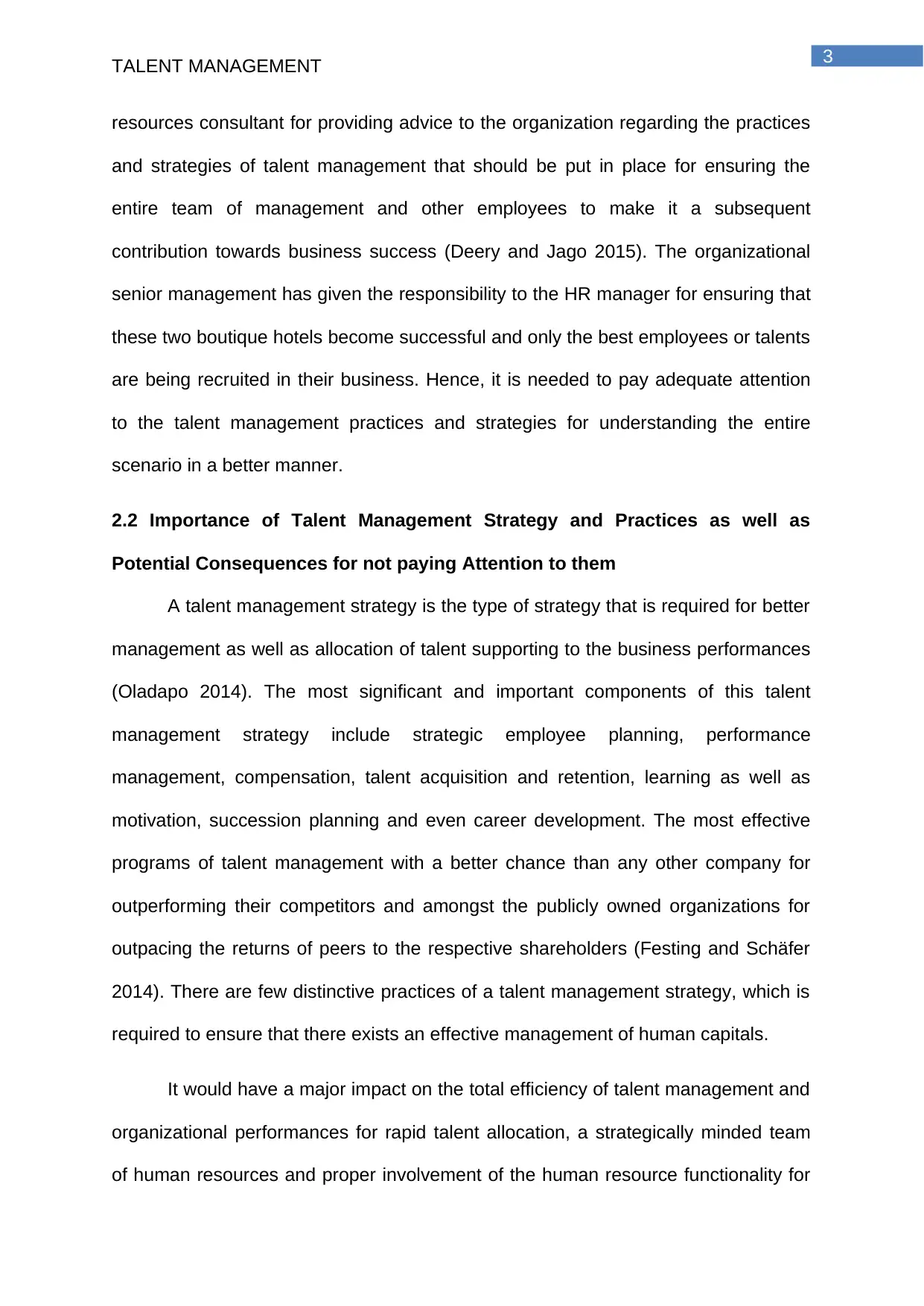
3
TALENT MANAGEMENT
resources consultant for providing advice to the organization regarding the practices
and strategies of talent management that should be put in place for ensuring the
entire team of management and other employees to make it a subsequent
contribution towards business success (Deery and Jago 2015). The organizational
senior management has given the responsibility to the HR manager for ensuring that
these two boutique hotels become successful and only the best employees or talents
are being recruited in their business. Hence, it is needed to pay adequate attention
to the talent management practices and strategies for understanding the entire
scenario in a better manner.
2.2 Importance of Talent Management Strategy and Practices as well as
Potential Consequences for not paying Attention to them
A talent management strategy is the type of strategy that is required for better
management as well as allocation of talent supporting to the business performances
(Oladapo 2014). The most significant and important components of this talent
management strategy include strategic employee planning, performance
management, compensation, talent acquisition and retention, learning as well as
motivation, succession planning and even career development. The most effective
programs of talent management with a better chance than any other company for
outperforming their competitors and amongst the publicly owned organizations for
outpacing the returns of peers to the respective shareholders (Festing and Schäfer
2014). There are few distinctive practices of a talent management strategy, which is
required to ensure that there exists an effective management of human capitals.
It would have a major impact on the total efficiency of talent management and
organizational performances for rapid talent allocation, a strategically minded team
of human resources and proper involvement of the human resource functionality for
TALENT MANAGEMENT
resources consultant for providing advice to the organization regarding the practices
and strategies of talent management that should be put in place for ensuring the
entire team of management and other employees to make it a subsequent
contribution towards business success (Deery and Jago 2015). The organizational
senior management has given the responsibility to the HR manager for ensuring that
these two boutique hotels become successful and only the best employees or talents
are being recruited in their business. Hence, it is needed to pay adequate attention
to the talent management practices and strategies for understanding the entire
scenario in a better manner.
2.2 Importance of Talent Management Strategy and Practices as well as
Potential Consequences for not paying Attention to them
A talent management strategy is the type of strategy that is required for better
management as well as allocation of talent supporting to the business performances
(Oladapo 2014). The most significant and important components of this talent
management strategy include strategic employee planning, performance
management, compensation, talent acquisition and retention, learning as well as
motivation, succession planning and even career development. The most effective
programs of talent management with a better chance than any other company for
outperforming their competitors and amongst the publicly owned organizations for
outpacing the returns of peers to the respective shareholders (Festing and Schäfer
2014). There are few distinctive practices of a talent management strategy, which is
required to ensure that there exists an effective management of human capitals.
It would have a major impact on the total efficiency of talent management and
organizational performances for rapid talent allocation, a strategically minded team
of human resources and proper involvement of the human resource functionality for
Secure Best Marks with AI Grader
Need help grading? Try our AI Grader for instant feedback on your assignments.
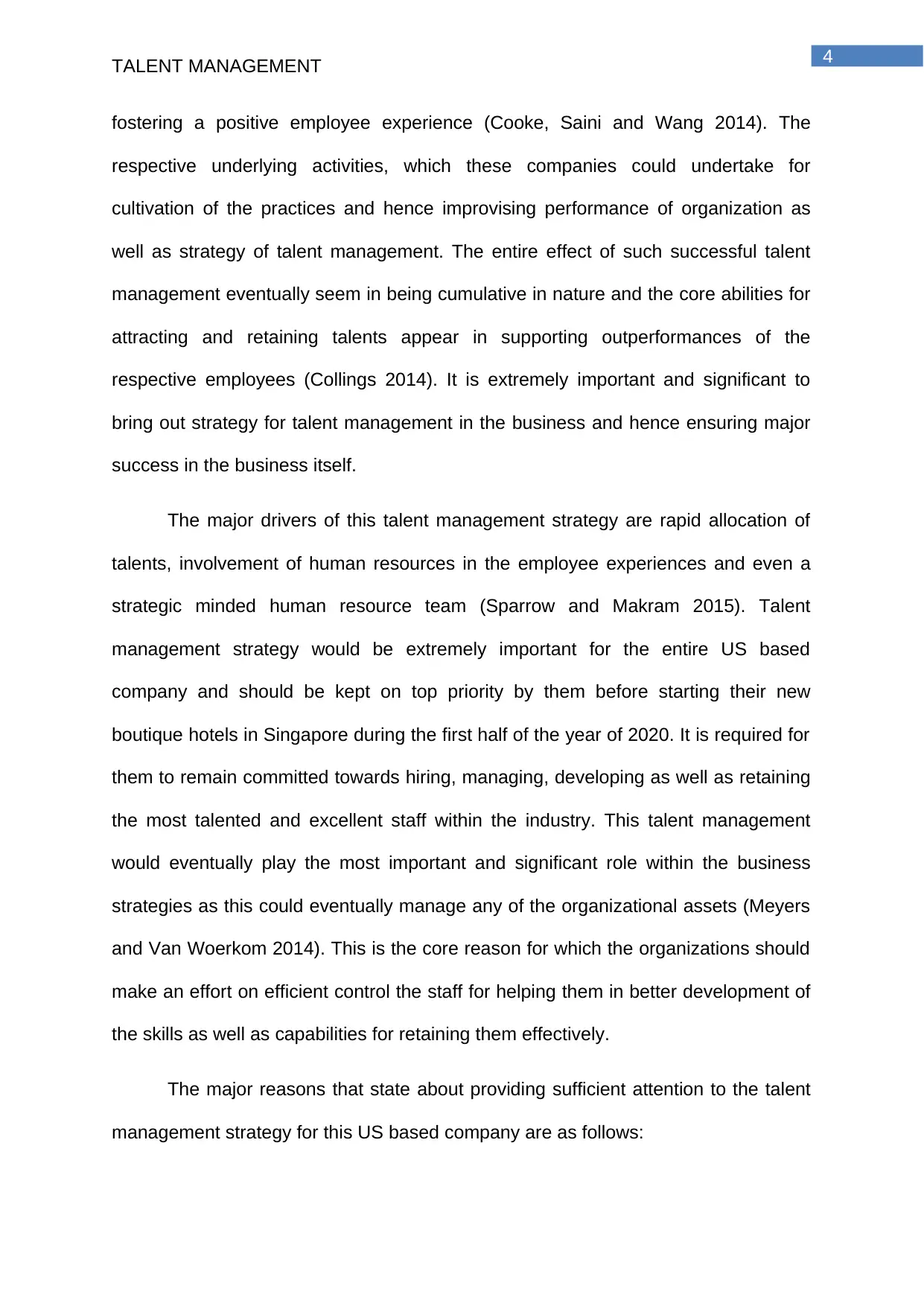
4
TALENT MANAGEMENT
fostering a positive employee experience (Cooke, Saini and Wang 2014). The
respective underlying activities, which these companies could undertake for
cultivation of the practices and hence improvising performance of organization as
well as strategy of talent management. The entire effect of such successful talent
management eventually seem in being cumulative in nature and the core abilities for
attracting and retaining talents appear in supporting outperformances of the
respective employees (Collings 2014). It is extremely important and significant to
bring out strategy for talent management in the business and hence ensuring major
success in the business itself.
The major drivers of this talent management strategy are rapid allocation of
talents, involvement of human resources in the employee experiences and even a
strategic minded human resource team (Sparrow and Makram 2015). Talent
management strategy would be extremely important for the entire US based
company and should be kept on top priority by them before starting their new
boutique hotels in Singapore during the first half of the year of 2020. It is required for
them to remain committed towards hiring, managing, developing as well as retaining
the most talented and excellent staff within the industry. This talent management
would eventually play the most important and significant role within the business
strategies as this could eventually manage any of the organizational assets (Meyers
and Van Woerkom 2014). This is the core reason for which the organizations should
make an effort on efficient control the staff for helping them in better development of
the skills as well as capabilities for retaining them effectively.
The major reasons that state about providing sufficient attention to the talent
management strategy for this US based company are as follows:
TALENT MANAGEMENT
fostering a positive employee experience (Cooke, Saini and Wang 2014). The
respective underlying activities, which these companies could undertake for
cultivation of the practices and hence improvising performance of organization as
well as strategy of talent management. The entire effect of such successful talent
management eventually seem in being cumulative in nature and the core abilities for
attracting and retaining talents appear in supporting outperformances of the
respective employees (Collings 2014). It is extremely important and significant to
bring out strategy for talent management in the business and hence ensuring major
success in the business itself.
The major drivers of this talent management strategy are rapid allocation of
talents, involvement of human resources in the employee experiences and even a
strategic minded human resource team (Sparrow and Makram 2015). Talent
management strategy would be extremely important for the entire US based
company and should be kept on top priority by them before starting their new
boutique hotels in Singapore during the first half of the year of 2020. It is required for
them to remain committed towards hiring, managing, developing as well as retaining
the most talented and excellent staff within the industry. This talent management
would eventually play the most important and significant role within the business
strategies as this could eventually manage any of the organizational assets (Meyers
and Van Woerkom 2014). This is the core reason for which the organizations should
make an effort on efficient control the staff for helping them in better development of
the skills as well as capabilities for retaining them effectively.
The major reasons that state about providing sufficient attention to the talent
management strategy for this US based company are as follows:
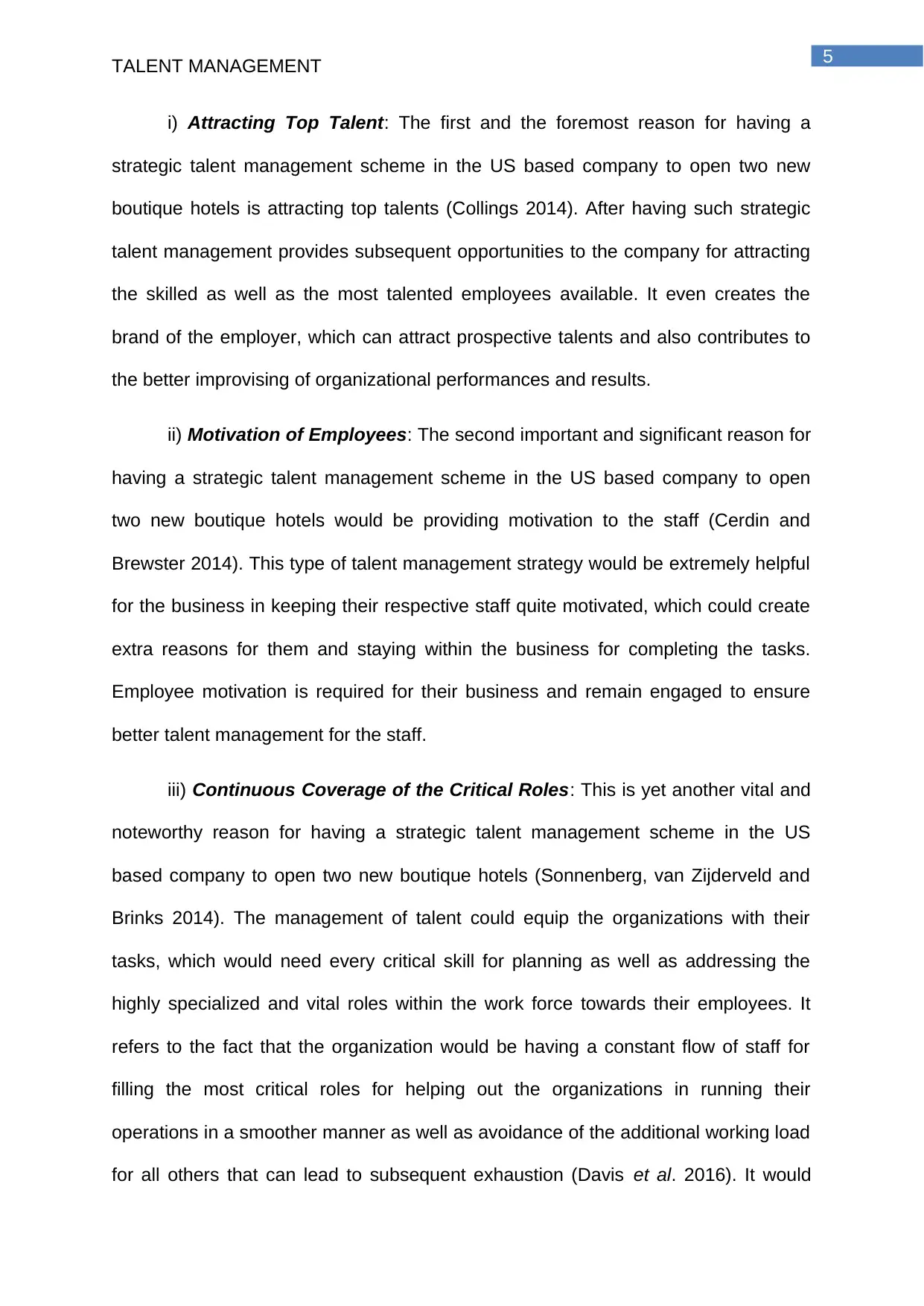
5
TALENT MANAGEMENT
i) Attracting Top Talent: The first and the foremost reason for having a
strategic talent management scheme in the US based company to open two new
boutique hotels is attracting top talents (Collings 2014). After having such strategic
talent management provides subsequent opportunities to the company for attracting
the skilled as well as the most talented employees available. It even creates the
brand of the employer, which can attract prospective talents and also contributes to
the better improvising of organizational performances and results.
ii) Motivation of Employees: The second important and significant reason for
having a strategic talent management scheme in the US based company to open
two new boutique hotels would be providing motivation to the staff (Cerdin and
Brewster 2014). This type of talent management strategy would be extremely helpful
for the business in keeping their respective staff quite motivated, which could create
extra reasons for them and staying within the business for completing the tasks.
Employee motivation is required for their business and remain engaged to ensure
better talent management for the staff.
iii) Continuous Coverage of the Critical Roles: This is yet another vital and
noteworthy reason for having a strategic talent management scheme in the US
based company to open two new boutique hotels (Sonnenberg, van Zijderveld and
Brinks 2014). The management of talent could equip the organizations with their
tasks, which would need every critical skill for planning as well as addressing the
highly specialized and vital roles within the work force towards their employees. It
refers to the fact that the organization would be having a constant flow of staff for
filling the most critical roles for helping out the organizations in running their
operations in a smoother manner as well as avoidance of the additional working load
for all others that can lead to subsequent exhaustion (Davis et al. 2016). It would
TALENT MANAGEMENT
i) Attracting Top Talent: The first and the foremost reason for having a
strategic talent management scheme in the US based company to open two new
boutique hotels is attracting top talents (Collings 2014). After having such strategic
talent management provides subsequent opportunities to the company for attracting
the skilled as well as the most talented employees available. It even creates the
brand of the employer, which can attract prospective talents and also contributes to
the better improvising of organizational performances and results.
ii) Motivation of Employees: The second important and significant reason for
having a strategic talent management scheme in the US based company to open
two new boutique hotels would be providing motivation to the staff (Cerdin and
Brewster 2014). This type of talent management strategy would be extremely helpful
for the business in keeping their respective staff quite motivated, which could create
extra reasons for them and staying within the business for completing the tasks.
Employee motivation is required for their business and remain engaged to ensure
better talent management for the staff.
iii) Continuous Coverage of the Critical Roles: This is yet another vital and
noteworthy reason for having a strategic talent management scheme in the US
based company to open two new boutique hotels (Sonnenberg, van Zijderveld and
Brinks 2014). The management of talent could equip the organizations with their
tasks, which would need every critical skill for planning as well as addressing the
highly specialized and vital roles within the work force towards their employees. It
refers to the fact that the organization would be having a constant flow of staff for
filling the most critical roles for helping out the organizations in running their
operations in a smoother manner as well as avoidance of the additional working load
for all others that can lead to subsequent exhaustion (Davis et al. 2016). It would
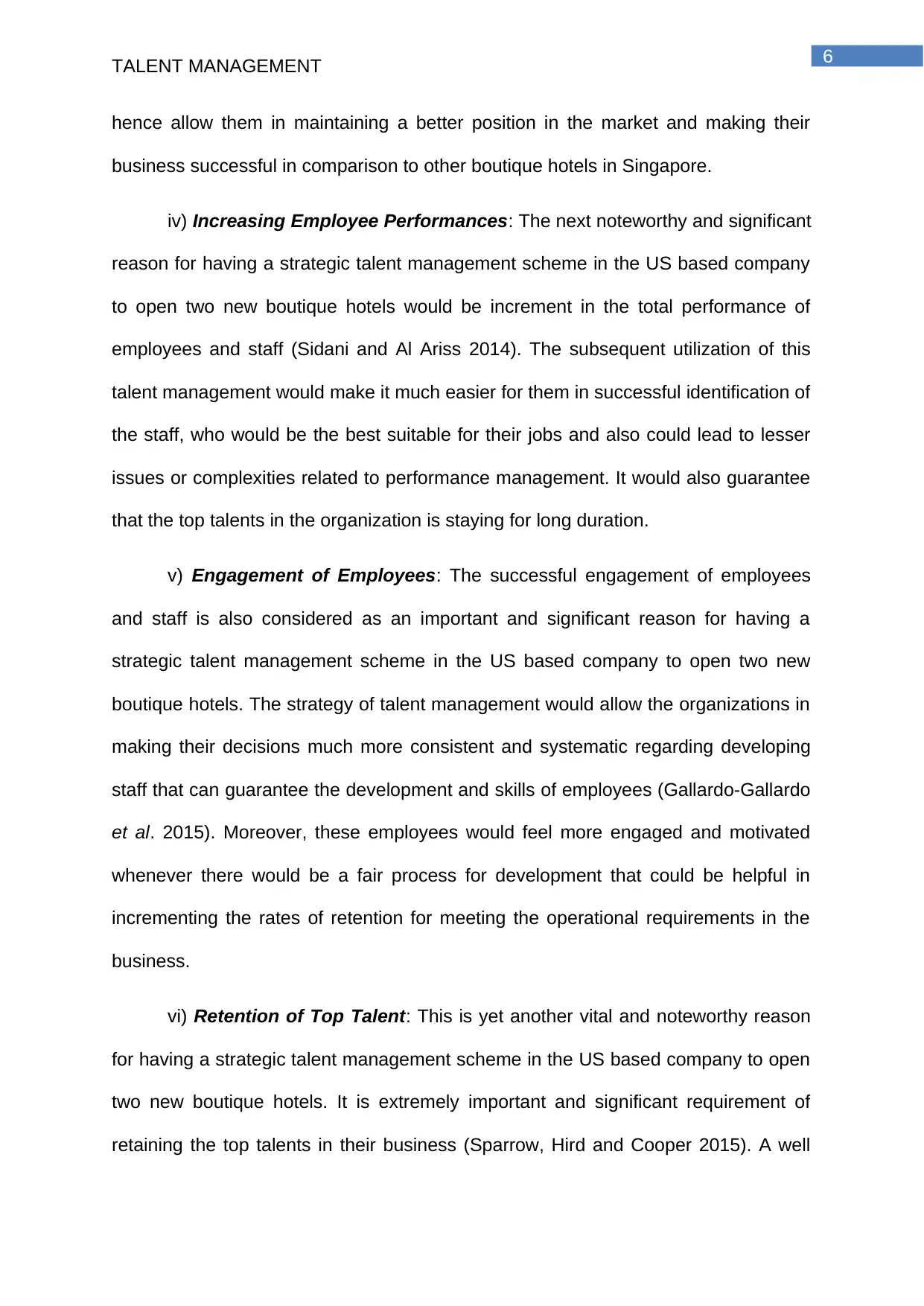
6
TALENT MANAGEMENT
hence allow them in maintaining a better position in the market and making their
business successful in comparison to other boutique hotels in Singapore.
iv) Increasing Employee Performances: The next noteworthy and significant
reason for having a strategic talent management scheme in the US based company
to open two new boutique hotels would be increment in the total performance of
employees and staff (Sidani and Al Ariss 2014). The subsequent utilization of this
talent management would make it much easier for them in successful identification of
the staff, who would be the best suitable for their jobs and also could lead to lesser
issues or complexities related to performance management. It would also guarantee
that the top talents in the organization is staying for long duration.
v) Engagement of Employees: The successful engagement of employees
and staff is also considered as an important and significant reason for having a
strategic talent management scheme in the US based company to open two new
boutique hotels. The strategy of talent management would allow the organizations in
making their decisions much more consistent and systematic regarding developing
staff that can guarantee the development and skills of employees (Gallardo-Gallardo
et al. 2015). Moreover, these employees would feel more engaged and motivated
whenever there would be a fair process for development that could be helpful in
incrementing the rates of retention for meeting the operational requirements in the
business.
vi) Retention of Top Talent: This is yet another vital and noteworthy reason
for having a strategic talent management scheme in the US based company to open
two new boutique hotels. It is extremely important and significant requirement of
retaining the top talents in their business (Sparrow, Hird and Cooper 2015). A well
TALENT MANAGEMENT
hence allow them in maintaining a better position in the market and making their
business successful in comparison to other boutique hotels in Singapore.
iv) Increasing Employee Performances: The next noteworthy and significant
reason for having a strategic talent management scheme in the US based company
to open two new boutique hotels would be increment in the total performance of
employees and staff (Sidani and Al Ariss 2014). The subsequent utilization of this
talent management would make it much easier for them in successful identification of
the staff, who would be the best suitable for their jobs and also could lead to lesser
issues or complexities related to performance management. It would also guarantee
that the top talents in the organization is staying for long duration.
v) Engagement of Employees: The successful engagement of employees
and staff is also considered as an important and significant reason for having a
strategic talent management scheme in the US based company to open two new
boutique hotels. The strategy of talent management would allow the organizations in
making their decisions much more consistent and systematic regarding developing
staff that can guarantee the development and skills of employees (Gallardo-Gallardo
et al. 2015). Moreover, these employees would feel more engaged and motivated
whenever there would be a fair process for development that could be helpful in
incrementing the rates of retention for meeting the operational requirements in the
business.
vi) Retention of Top Talent: This is yet another vital and noteworthy reason
for having a strategic talent management scheme in the US based company to open
two new boutique hotels. It is extremely important and significant requirement of
retaining the top talents in their business (Sparrow, Hird and Cooper 2015). A well
Paraphrase This Document
Need a fresh take? Get an instant paraphrase of this document with our AI Paraphraser
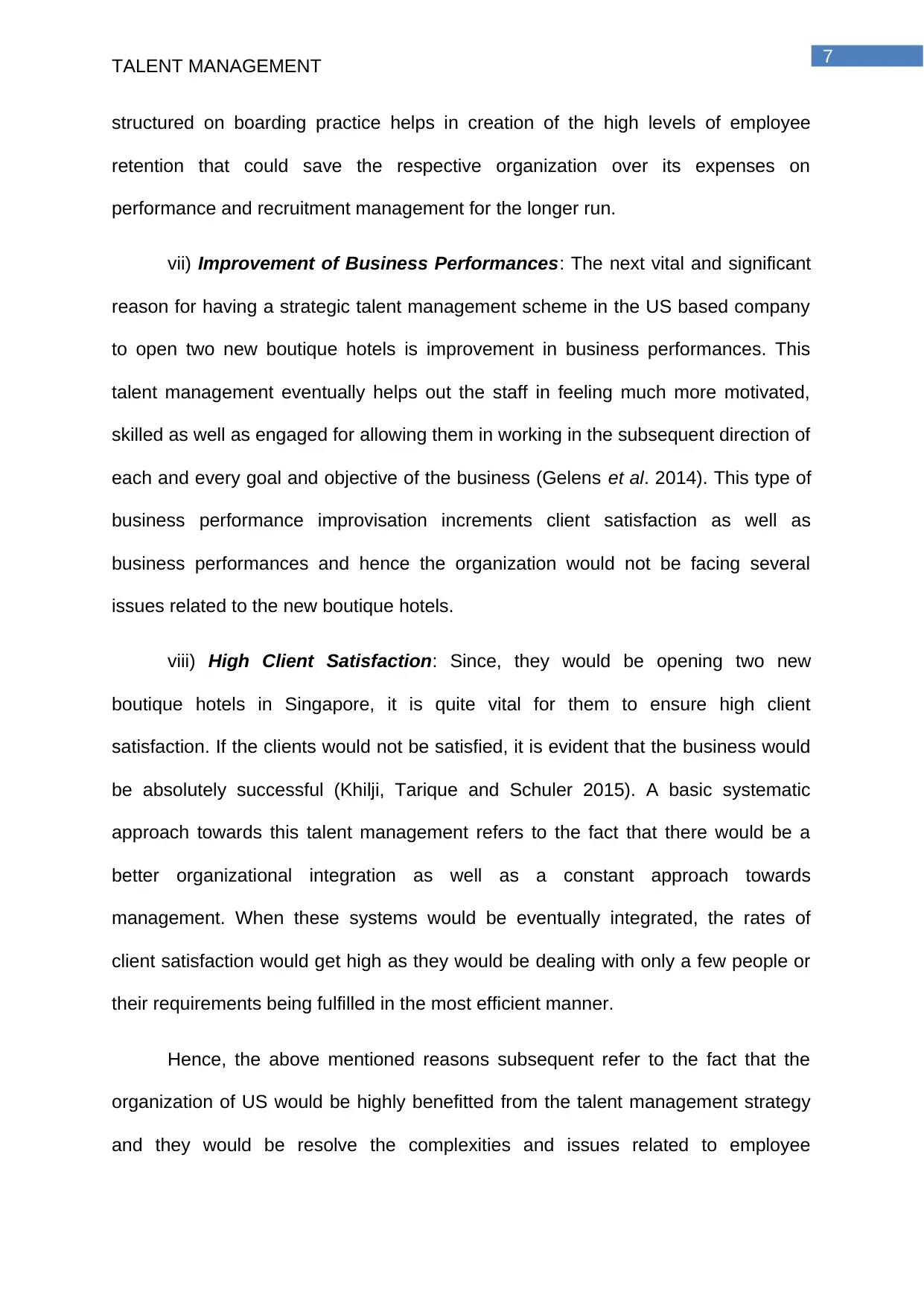
7
TALENT MANAGEMENT
structured on boarding practice helps in creation of the high levels of employee
retention that could save the respective organization over its expenses on
performance and recruitment management for the longer run.
vii) Improvement of Business Performances: The next vital and significant
reason for having a strategic talent management scheme in the US based company
to open two new boutique hotels is improvement in business performances. This
talent management eventually helps out the staff in feeling much more motivated,
skilled as well as engaged for allowing them in working in the subsequent direction of
each and every goal and objective of the business (Gelens et al. 2014). This type of
business performance improvisation increments client satisfaction as well as
business performances and hence the organization would not be facing several
issues related to the new boutique hotels.
viii) High Client Satisfaction: Since, they would be opening two new
boutique hotels in Singapore, it is quite vital for them to ensure high client
satisfaction. If the clients would not be satisfied, it is evident that the business would
be absolutely successful (Khilji, Tarique and Schuler 2015). A basic systematic
approach towards this talent management refers to the fact that there would be a
better organizational integration as well as a constant approach towards
management. When these systems would be eventually integrated, the rates of
client satisfaction would get high as they would be dealing with only a few people or
their requirements being fulfilled in the most efficient manner.
Hence, the above mentioned reasons subsequent refer to the fact that the
organization of US would be highly benefitted from the talent management strategy
and they would be resolve the complexities and issues related to employee
TALENT MANAGEMENT
structured on boarding practice helps in creation of the high levels of employee
retention that could save the respective organization over its expenses on
performance and recruitment management for the longer run.
vii) Improvement of Business Performances: The next vital and significant
reason for having a strategic talent management scheme in the US based company
to open two new boutique hotels is improvement in business performances. This
talent management eventually helps out the staff in feeling much more motivated,
skilled as well as engaged for allowing them in working in the subsequent direction of
each and every goal and objective of the business (Gelens et al. 2014). This type of
business performance improvisation increments client satisfaction as well as
business performances and hence the organization would not be facing several
issues related to the new boutique hotels.
viii) High Client Satisfaction: Since, they would be opening two new
boutique hotels in Singapore, it is quite vital for them to ensure high client
satisfaction. If the clients would not be satisfied, it is evident that the business would
be absolutely successful (Khilji, Tarique and Schuler 2015). A basic systematic
approach towards this talent management refers to the fact that there would be a
better organizational integration as well as a constant approach towards
management. When these systems would be eventually integrated, the rates of
client satisfaction would get high as they would be dealing with only a few people or
their requirements being fulfilled in the most efficient manner.
Hence, the above mentioned reasons subsequent refer to the fact that the
organization of US would be highly benefitted from the talent management strategy
and they would be resolve the complexities and issues related to employee
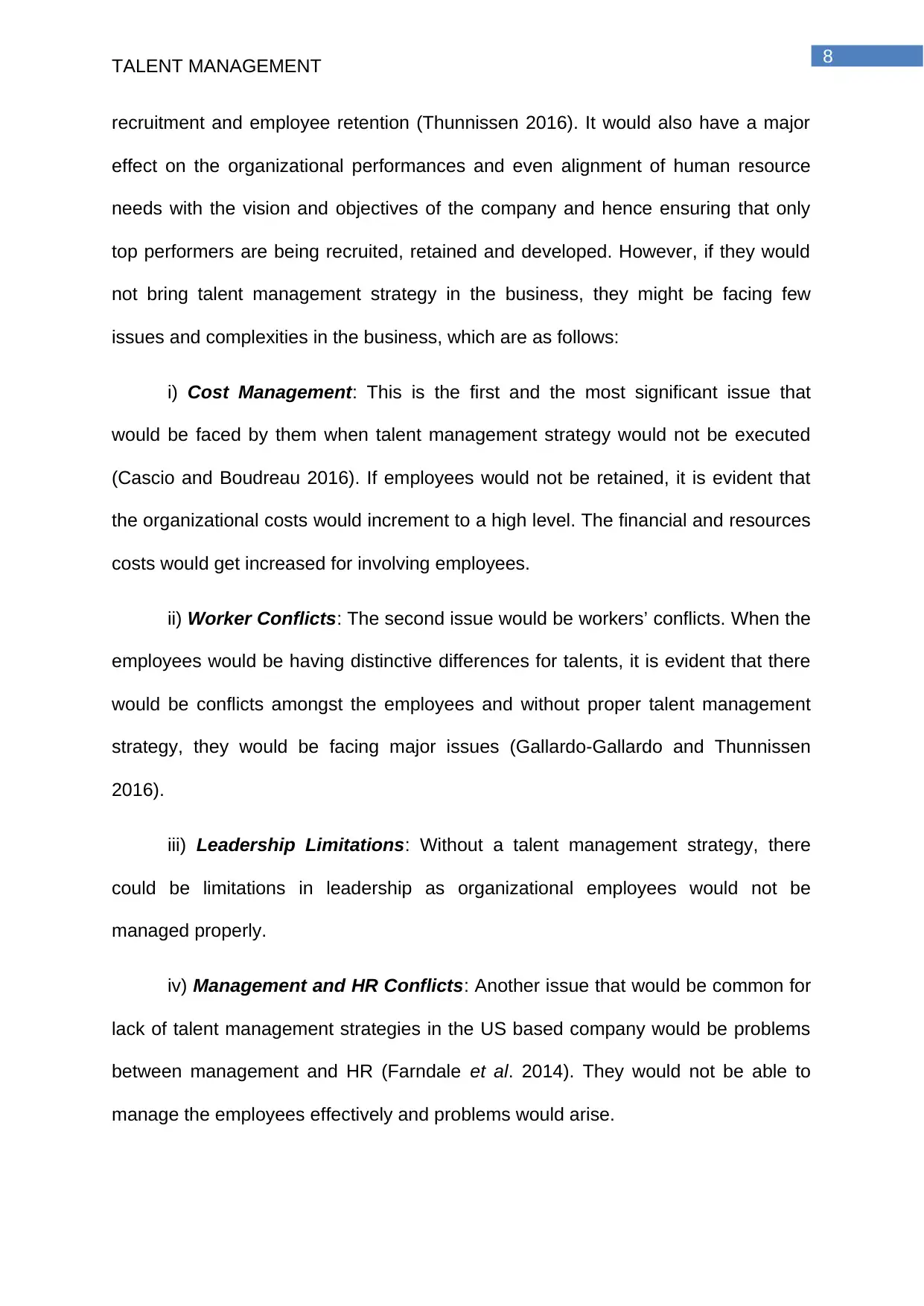
8
TALENT MANAGEMENT
recruitment and employee retention (Thunnissen 2016). It would also have a major
effect on the organizational performances and even alignment of human resource
needs with the vision and objectives of the company and hence ensuring that only
top performers are being recruited, retained and developed. However, if they would
not bring talent management strategy in the business, they might be facing few
issues and complexities in the business, which are as follows:
i) Cost Management: This is the first and the most significant issue that
would be faced by them when talent management strategy would not be executed
(Cascio and Boudreau 2016). If employees would not be retained, it is evident that
the organizational costs would increment to a high level. The financial and resources
costs would get increased for involving employees.
ii) Worker Conflicts: The second issue would be workers’ conflicts. When the
employees would be having distinctive differences for talents, it is evident that there
would be conflicts amongst the employees and without proper talent management
strategy, they would be facing major issues (Gallardo-Gallardo and Thunnissen
2016).
iii) Leadership Limitations: Without a talent management strategy, there
could be limitations in leadership as organizational employees would not be
managed properly.
iv) Management and HR Conflicts: Another issue that would be common for
lack of talent management strategies in the US based company would be problems
between management and HR (Farndale et al. 2014). They would not be able to
manage the employees effectively and problems would arise.
TALENT MANAGEMENT
recruitment and employee retention (Thunnissen 2016). It would also have a major
effect on the organizational performances and even alignment of human resource
needs with the vision and objectives of the company and hence ensuring that only
top performers are being recruited, retained and developed. However, if they would
not bring talent management strategy in the business, they might be facing few
issues and complexities in the business, which are as follows:
i) Cost Management: This is the first and the most significant issue that
would be faced by them when talent management strategy would not be executed
(Cascio and Boudreau 2016). If employees would not be retained, it is evident that
the organizational costs would increment to a high level. The financial and resources
costs would get increased for involving employees.
ii) Worker Conflicts: The second issue would be workers’ conflicts. When the
employees would be having distinctive differences for talents, it is evident that there
would be conflicts amongst the employees and without proper talent management
strategy, they would be facing major issues (Gallardo-Gallardo and Thunnissen
2016).
iii) Leadership Limitations: Without a talent management strategy, there
could be limitations in leadership as organizational employees would not be
managed properly.
iv) Management and HR Conflicts: Another issue that would be common for
lack of talent management strategies in the US based company would be problems
between management and HR (Farndale et al. 2014). They would not be able to
manage the employees effectively and problems would arise.
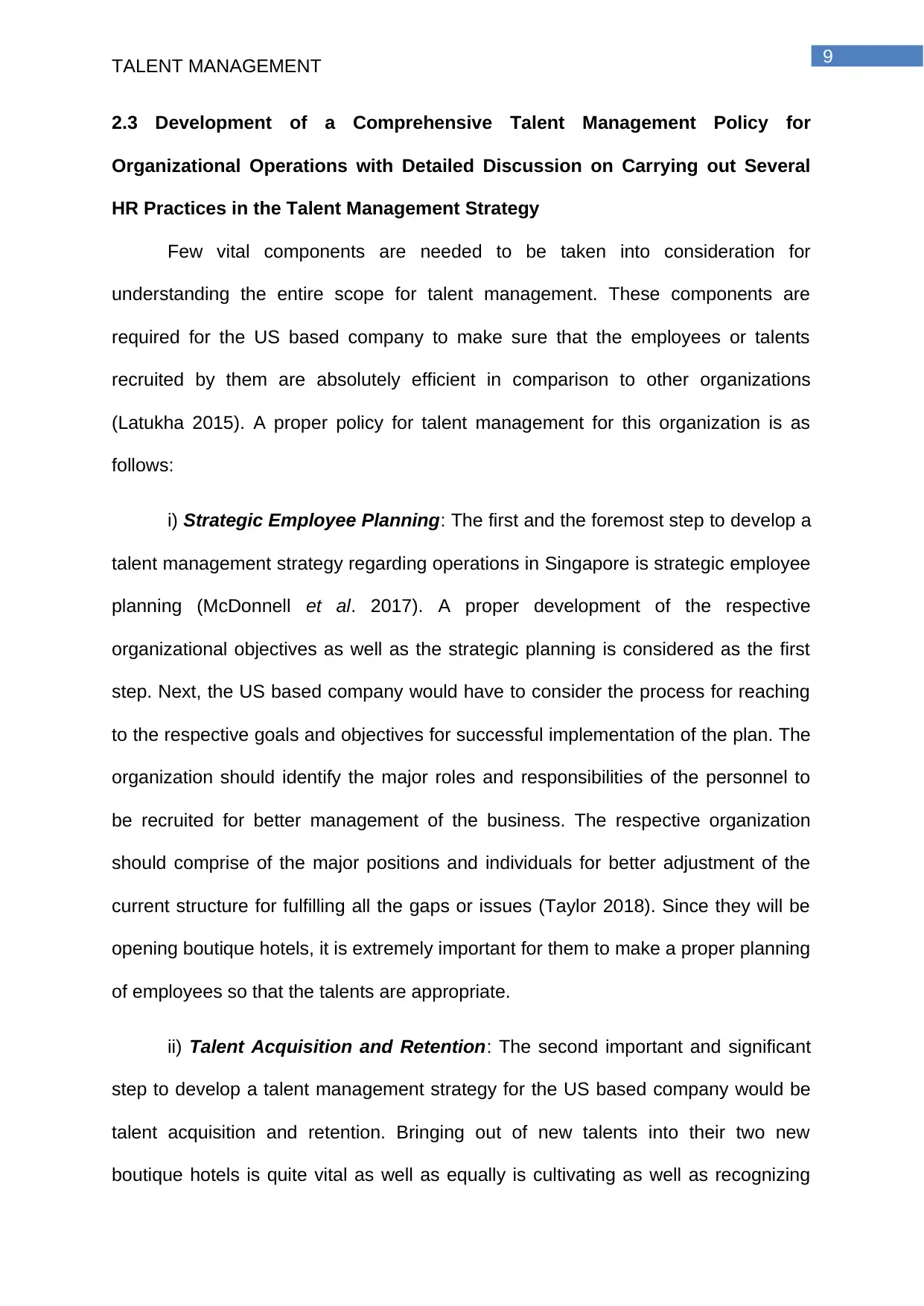
9
TALENT MANAGEMENT
2.3 Development of a Comprehensive Talent Management Policy for
Organizational Operations with Detailed Discussion on Carrying out Several
HR Practices in the Talent Management Strategy
Few vital components are needed to be taken into consideration for
understanding the entire scope for talent management. These components are
required for the US based company to make sure that the employees or talents
recruited by them are absolutely efficient in comparison to other organizations
(Latukha 2015). A proper policy for talent management for this organization is as
follows:
i) Strategic Employee Planning: The first and the foremost step to develop a
talent management strategy regarding operations in Singapore is strategic employee
planning (McDonnell et al. 2017). A proper development of the respective
organizational objectives as well as the strategic planning is considered as the first
step. Next, the US based company would have to consider the process for reaching
to the respective goals and objectives for successful implementation of the plan. The
organization should identify the major roles and responsibilities of the personnel to
be recruited for better management of the business. The respective organization
should comprise of the major positions and individuals for better adjustment of the
current structure for fulfilling all the gaps or issues (Taylor 2018). Since they will be
opening boutique hotels, it is extremely important for them to make a proper planning
of employees so that the talents are appropriate.
ii) Talent Acquisition and Retention: The second important and significant
step to develop a talent management strategy for the US based company would be
talent acquisition and retention. Bringing out of new talents into their two new
boutique hotels is quite vital as well as equally is cultivating as well as recognizing
TALENT MANAGEMENT
2.3 Development of a Comprehensive Talent Management Policy for
Organizational Operations with Detailed Discussion on Carrying out Several
HR Practices in the Talent Management Strategy
Few vital components are needed to be taken into consideration for
understanding the entire scope for talent management. These components are
required for the US based company to make sure that the employees or talents
recruited by them are absolutely efficient in comparison to other organizations
(Latukha 2015). A proper policy for talent management for this organization is as
follows:
i) Strategic Employee Planning: The first and the foremost step to develop a
talent management strategy regarding operations in Singapore is strategic employee
planning (McDonnell et al. 2017). A proper development of the respective
organizational objectives as well as the strategic planning is considered as the first
step. Next, the US based company would have to consider the process for reaching
to the respective goals and objectives for successful implementation of the plan. The
organization should identify the major roles and responsibilities of the personnel to
be recruited for better management of the business. The respective organization
should comprise of the major positions and individuals for better adjustment of the
current structure for fulfilling all the gaps or issues (Taylor 2018). Since they will be
opening boutique hotels, it is extremely important for them to make a proper planning
of employees so that the talents are appropriate.
ii) Talent Acquisition and Retention: The second important and significant
step to develop a talent management strategy for the US based company would be
talent acquisition and retention. Bringing out of new talents into their two new
boutique hotels is quite vital as well as equally is cultivating as well as recognizing
Secure Best Marks with AI Grader
Need help grading? Try our AI Grader for instant feedback on your assignments.
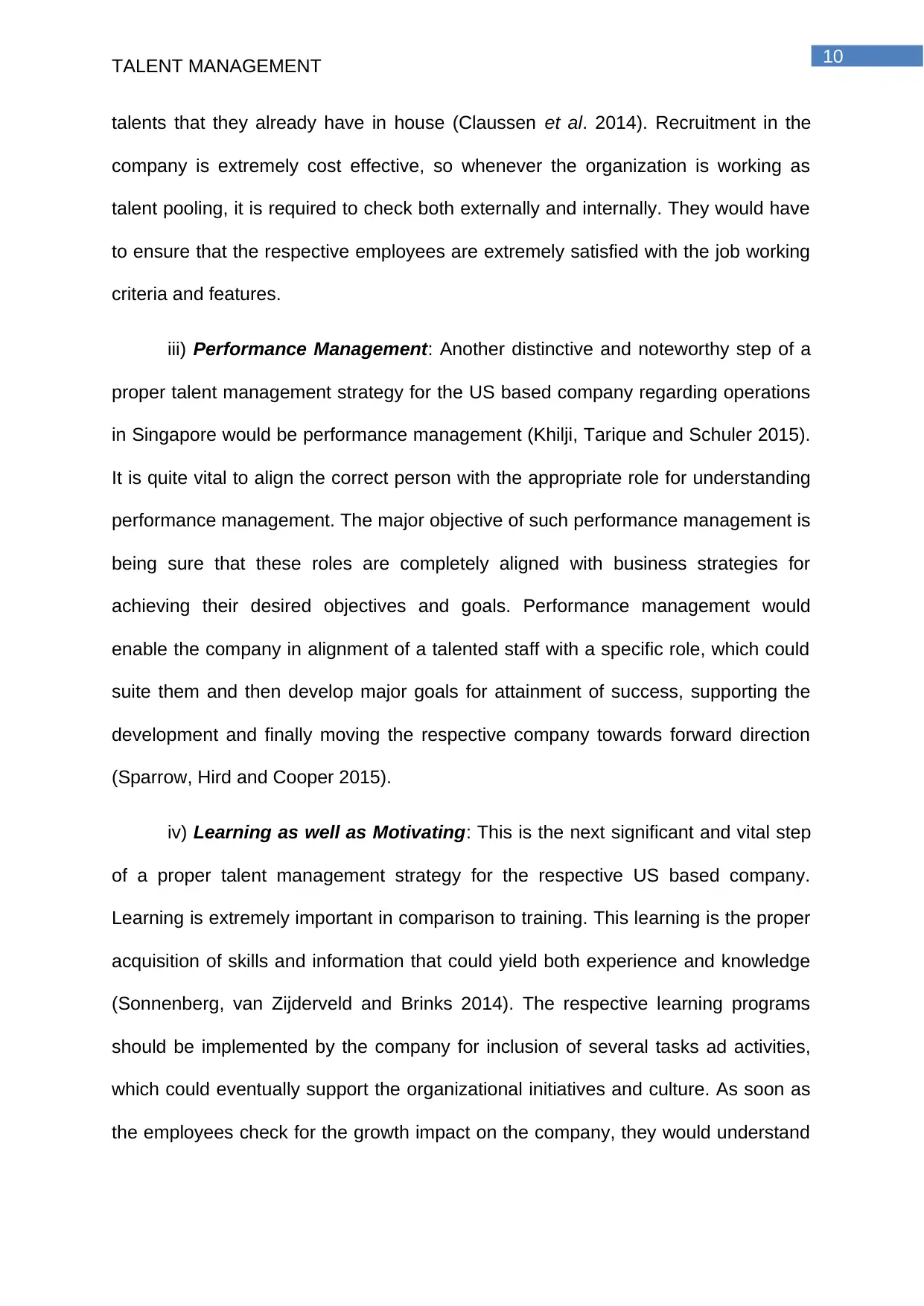
10
TALENT MANAGEMENT
talents that they already have in house (Claussen et al. 2014). Recruitment in the
company is extremely cost effective, so whenever the organization is working as
talent pooling, it is required to check both externally and internally. They would have
to ensure that the respective employees are extremely satisfied with the job working
criteria and features.
iii) Performance Management: Another distinctive and noteworthy step of a
proper talent management strategy for the US based company regarding operations
in Singapore would be performance management (Khilji, Tarique and Schuler 2015).
It is quite vital to align the correct person with the appropriate role for understanding
performance management. The major objective of such performance management is
being sure that these roles are completely aligned with business strategies for
achieving their desired objectives and goals. Performance management would
enable the company in alignment of a talented staff with a specific role, which could
suite them and then develop major goals for attainment of success, supporting the
development and finally moving the respective company towards forward direction
(Sparrow, Hird and Cooper 2015).
iv) Learning as well as Motivating: This is the next significant and vital step
of a proper talent management strategy for the respective US based company.
Learning is extremely important in comparison to training. This learning is the proper
acquisition of skills and information that could yield both experience and knowledge
(Sonnenberg, van Zijderveld and Brinks 2014). The respective learning programs
should be implemented by the company for inclusion of several tasks ad activities,
which could eventually support the organizational initiatives and culture. As soon as
the employees check for the growth impact on the company, they would understand
TALENT MANAGEMENT
talents that they already have in house (Claussen et al. 2014). Recruitment in the
company is extremely cost effective, so whenever the organization is working as
talent pooling, it is required to check both externally and internally. They would have
to ensure that the respective employees are extremely satisfied with the job working
criteria and features.
iii) Performance Management: Another distinctive and noteworthy step of a
proper talent management strategy for the US based company regarding operations
in Singapore would be performance management (Khilji, Tarique and Schuler 2015).
It is quite vital to align the correct person with the appropriate role for understanding
performance management. The major objective of such performance management is
being sure that these roles are completely aligned with business strategies for
achieving their desired objectives and goals. Performance management would
enable the company in alignment of a talented staff with a specific role, which could
suite them and then develop major goals for attainment of success, supporting the
development and finally moving the respective company towards forward direction
(Sparrow, Hird and Cooper 2015).
iv) Learning as well as Motivating: This is the next significant and vital step
of a proper talent management strategy for the respective US based company.
Learning is extremely important in comparison to training. This learning is the proper
acquisition of skills and information that could yield both experience and knowledge
(Sonnenberg, van Zijderveld and Brinks 2014). The respective learning programs
should be implemented by the company for inclusion of several tasks ad activities,
which could eventually support the organizational initiatives and culture. As soon as
the employees check for the growth impact on the company, they would understand
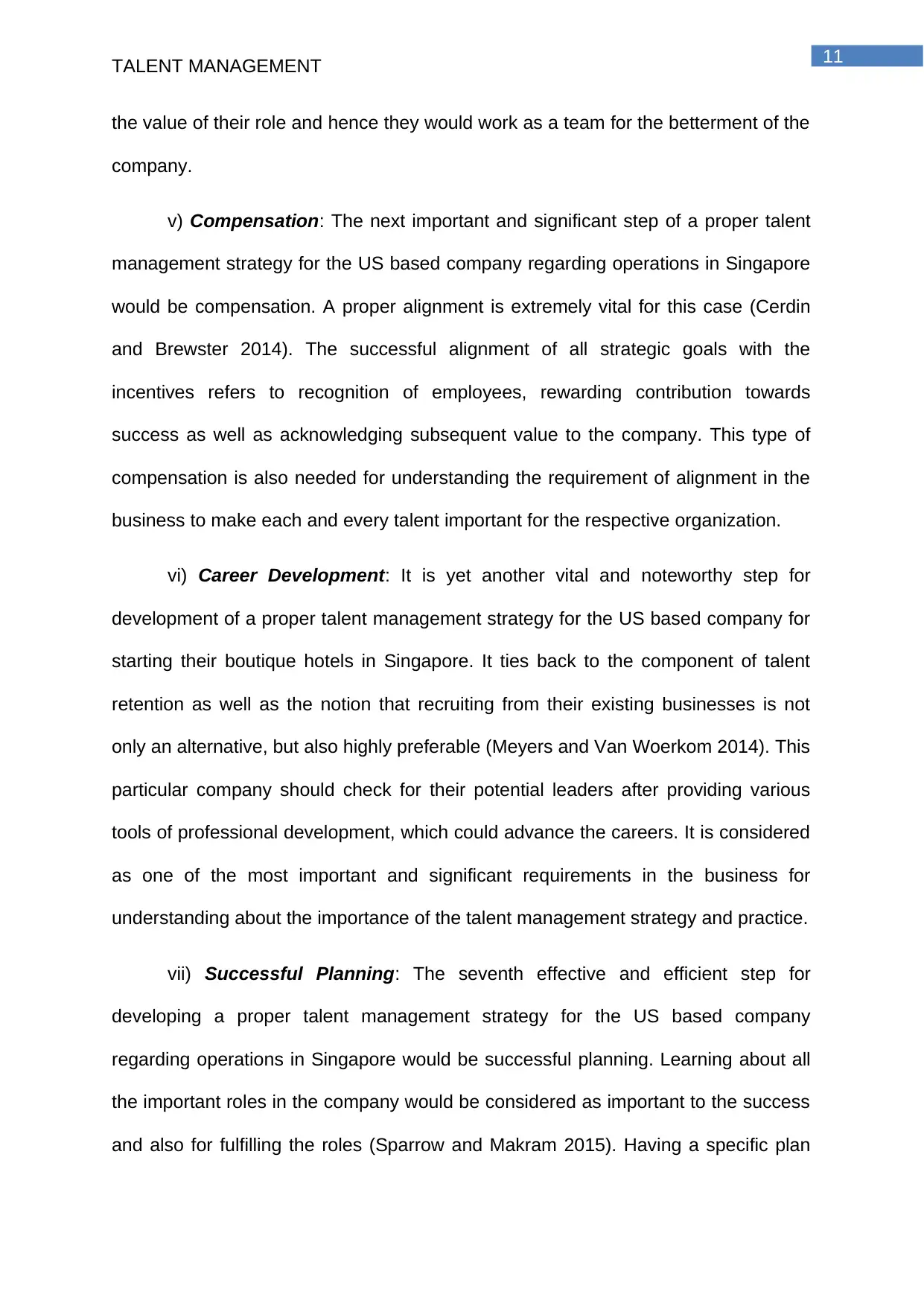
11
TALENT MANAGEMENT
the value of their role and hence they would work as a team for the betterment of the
company.
v) Compensation: The next important and significant step of a proper talent
management strategy for the US based company regarding operations in Singapore
would be compensation. A proper alignment is extremely vital for this case (Cerdin
and Brewster 2014). The successful alignment of all strategic goals with the
incentives refers to recognition of employees, rewarding contribution towards
success as well as acknowledging subsequent value to the company. This type of
compensation is also needed for understanding the requirement of alignment in the
business to make each and every talent important for the respective organization.
vi) Career Development: It is yet another vital and noteworthy step for
development of a proper talent management strategy for the US based company for
starting their boutique hotels in Singapore. It ties back to the component of talent
retention as well as the notion that recruiting from their existing businesses is not
only an alternative, but also highly preferable (Meyers and Van Woerkom 2014). This
particular company should check for their potential leaders after providing various
tools of professional development, which could advance the careers. It is considered
as one of the most important and significant requirements in the business for
understanding about the importance of the talent management strategy and practice.
vii) Successful Planning: The seventh effective and efficient step for
developing a proper talent management strategy for the US based company
regarding operations in Singapore would be successful planning. Learning about all
the important roles in the company would be considered as important to the success
and also for fulfilling the roles (Sparrow and Makram 2015). Having a specific plan
TALENT MANAGEMENT
the value of their role and hence they would work as a team for the betterment of the
company.
v) Compensation: The next important and significant step of a proper talent
management strategy for the US based company regarding operations in Singapore
would be compensation. A proper alignment is extremely vital for this case (Cerdin
and Brewster 2014). The successful alignment of all strategic goals with the
incentives refers to recognition of employees, rewarding contribution towards
success as well as acknowledging subsequent value to the company. This type of
compensation is also needed for understanding the requirement of alignment in the
business to make each and every talent important for the respective organization.
vi) Career Development: It is yet another vital and noteworthy step for
development of a proper talent management strategy for the US based company for
starting their boutique hotels in Singapore. It ties back to the component of talent
retention as well as the notion that recruiting from their existing businesses is not
only an alternative, but also highly preferable (Meyers and Van Woerkom 2014). This
particular company should check for their potential leaders after providing various
tools of professional development, which could advance the careers. It is considered
as one of the most important and significant requirements in the business for
understanding about the importance of the talent management strategy and practice.
vii) Successful Planning: The seventh effective and efficient step for
developing a proper talent management strategy for the US based company
regarding operations in Singapore would be successful planning. Learning about all
the important roles in the company would be considered as important to the success
and also for fulfilling the roles (Sparrow and Makram 2015). Having a specific plan
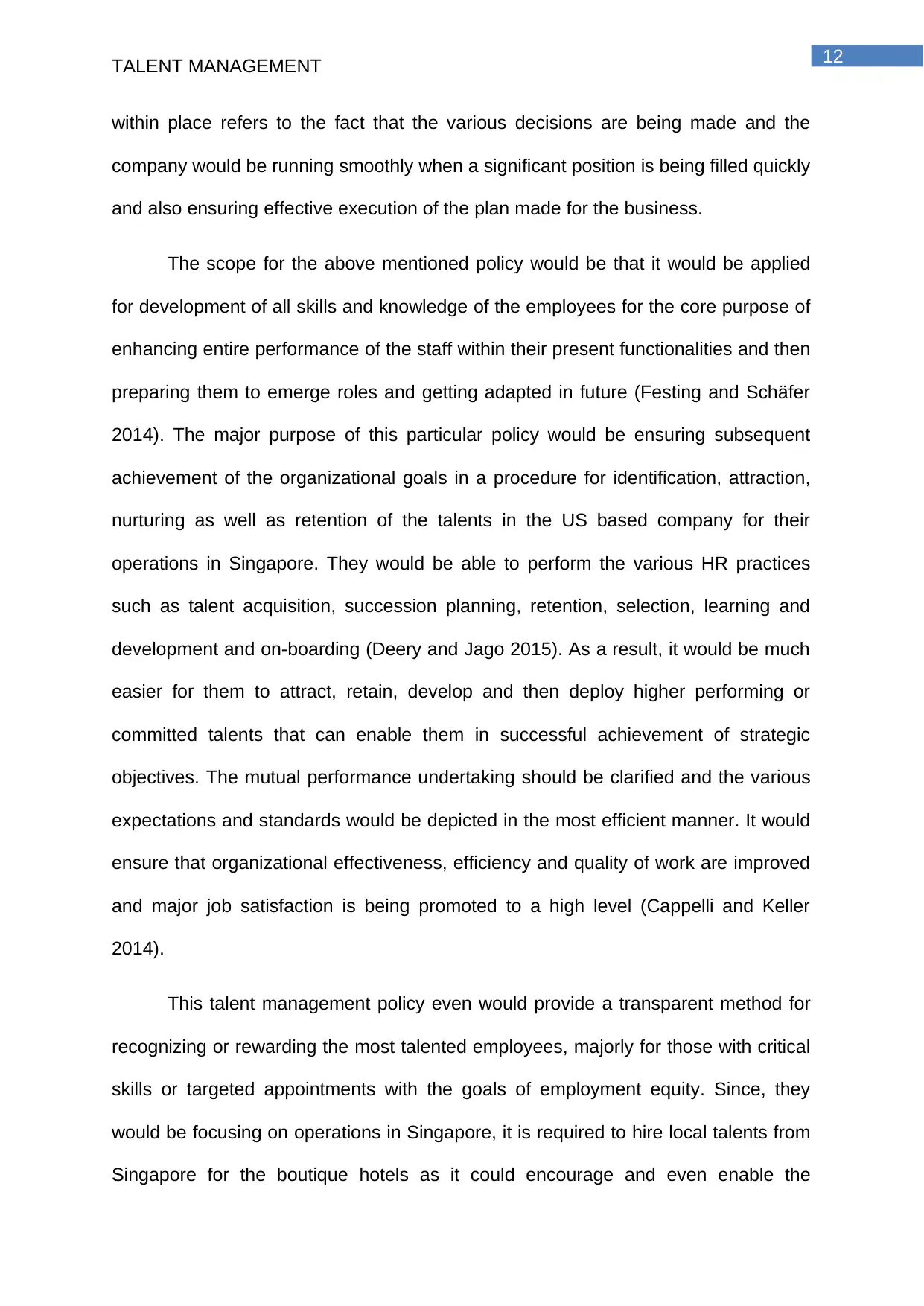
12
TALENT MANAGEMENT
within place refers to the fact that the various decisions are being made and the
company would be running smoothly when a significant position is being filled quickly
and also ensuring effective execution of the plan made for the business.
The scope for the above mentioned policy would be that it would be applied
for development of all skills and knowledge of the employees for the core purpose of
enhancing entire performance of the staff within their present functionalities and then
preparing them to emerge roles and getting adapted in future (Festing and Schäfer
2014). The major purpose of this particular policy would be ensuring subsequent
achievement of the organizational goals in a procedure for identification, attraction,
nurturing as well as retention of the talents in the US based company for their
operations in Singapore. They would be able to perform the various HR practices
such as talent acquisition, succession planning, retention, selection, learning and
development and on-boarding (Deery and Jago 2015). As a result, it would be much
easier for them to attract, retain, develop and then deploy higher performing or
committed talents that can enable them in successful achievement of strategic
objectives. The mutual performance undertaking should be clarified and the various
expectations and standards would be depicted in the most efficient manner. It would
ensure that organizational effectiveness, efficiency and quality of work are improved
and major job satisfaction is being promoted to a high level (Cappelli and Keller
2014).
This talent management policy even would provide a transparent method for
recognizing or rewarding the most talented employees, majorly for those with critical
skills or targeted appointments with the goals of employment equity. Since, they
would be focusing on operations in Singapore, it is required to hire local talents from
Singapore for the boutique hotels as it could encourage and even enable the
TALENT MANAGEMENT
within place refers to the fact that the various decisions are being made and the
company would be running smoothly when a significant position is being filled quickly
and also ensuring effective execution of the plan made for the business.
The scope for the above mentioned policy would be that it would be applied
for development of all skills and knowledge of the employees for the core purpose of
enhancing entire performance of the staff within their present functionalities and then
preparing them to emerge roles and getting adapted in future (Festing and Schäfer
2014). The major purpose of this particular policy would be ensuring subsequent
achievement of the organizational goals in a procedure for identification, attraction,
nurturing as well as retention of the talents in the US based company for their
operations in Singapore. They would be able to perform the various HR practices
such as talent acquisition, succession planning, retention, selection, learning and
development and on-boarding (Deery and Jago 2015). As a result, it would be much
easier for them to attract, retain, develop and then deploy higher performing or
committed talents that can enable them in successful achievement of strategic
objectives. The mutual performance undertaking should be clarified and the various
expectations and standards would be depicted in the most efficient manner. It would
ensure that organizational effectiveness, efficiency and quality of work are improved
and major job satisfaction is being promoted to a high level (Cappelli and Keller
2014).
This talent management policy even would provide a transparent method for
recognizing or rewarding the most talented employees, majorly for those with critical
skills or targeted appointments with the goals of employment equity. Since, they
would be focusing on operations in Singapore, it is required to hire local talents from
Singapore for the boutique hotels as it could encourage and even enable the
Paraphrase This Document
Need a fresh take? Get an instant paraphrase of this document with our AI Paraphraser
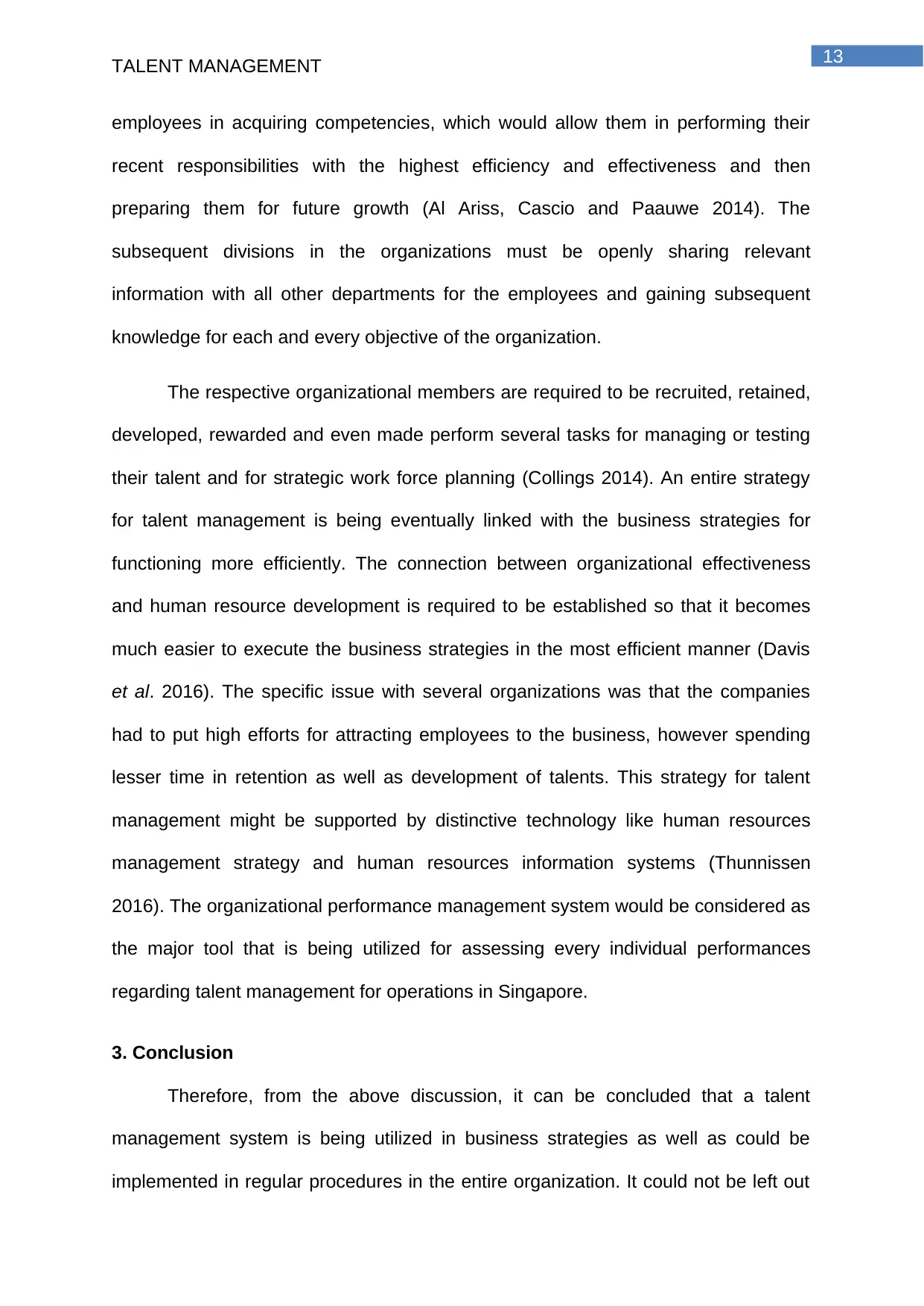
13
TALENT MANAGEMENT
employees in acquiring competencies, which would allow them in performing their
recent responsibilities with the highest efficiency and effectiveness and then
preparing them for future growth (Al Ariss, Cascio and Paauwe 2014). The
subsequent divisions in the organizations must be openly sharing relevant
information with all other departments for the employees and gaining subsequent
knowledge for each and every objective of the organization.
The respective organizational members are required to be recruited, retained,
developed, rewarded and even made perform several tasks for managing or testing
their talent and for strategic work force planning (Collings 2014). An entire strategy
for talent management is being eventually linked with the business strategies for
functioning more efficiently. The connection between organizational effectiveness
and human resource development is required to be established so that it becomes
much easier to execute the business strategies in the most efficient manner (Davis
et al. 2016). The specific issue with several organizations was that the companies
had to put high efforts for attracting employees to the business, however spending
lesser time in retention as well as development of talents. This strategy for talent
management might be supported by distinctive technology like human resources
management strategy and human resources information systems (Thunnissen
2016). The organizational performance management system would be considered as
the major tool that is being utilized for assessing every individual performances
regarding talent management for operations in Singapore.
3. Conclusion
Therefore, from the above discussion, it can be concluded that a talent
management system is being utilized in business strategies as well as could be
implemented in regular procedures in the entire organization. It could not be left out
TALENT MANAGEMENT
employees in acquiring competencies, which would allow them in performing their
recent responsibilities with the highest efficiency and effectiveness and then
preparing them for future growth (Al Ariss, Cascio and Paauwe 2014). The
subsequent divisions in the organizations must be openly sharing relevant
information with all other departments for the employees and gaining subsequent
knowledge for each and every objective of the organization.
The respective organizational members are required to be recruited, retained,
developed, rewarded and even made perform several tasks for managing or testing
their talent and for strategic work force planning (Collings 2014). An entire strategy
for talent management is being eventually linked with the business strategies for
functioning more efficiently. The connection between organizational effectiveness
and human resource development is required to be established so that it becomes
much easier to execute the business strategies in the most efficient manner (Davis
et al. 2016). The specific issue with several organizations was that the companies
had to put high efforts for attracting employees to the business, however spending
lesser time in retention as well as development of talents. This strategy for talent
management might be supported by distinctive technology like human resources
management strategy and human resources information systems (Thunnissen
2016). The organizational performance management system would be considered as
the major tool that is being utilized for assessing every individual performances
regarding talent management for operations in Singapore.
3. Conclusion
Therefore, from the above discussion, it can be concluded that a talent
management system is being utilized in business strategies as well as could be
implemented in regular procedures in the entire organization. It could not be left out
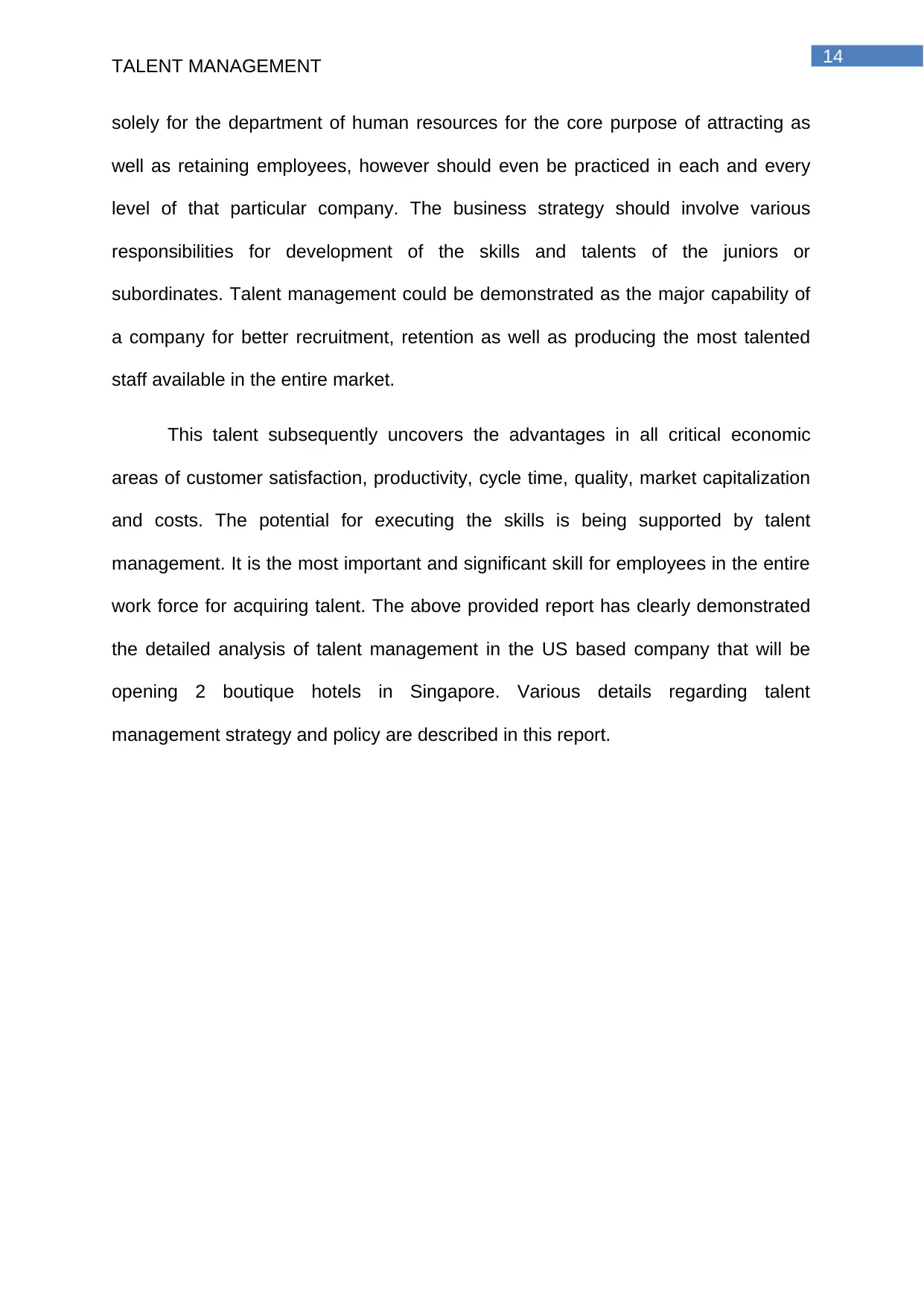
14
TALENT MANAGEMENT
solely for the department of human resources for the core purpose of attracting as
well as retaining employees, however should even be practiced in each and every
level of that particular company. The business strategy should involve various
responsibilities for development of the skills and talents of the juniors or
subordinates. Talent management could be demonstrated as the major capability of
a company for better recruitment, retention as well as producing the most talented
staff available in the entire market.
This talent subsequently uncovers the advantages in all critical economic
areas of customer satisfaction, productivity, cycle time, quality, market capitalization
and costs. The potential for executing the skills is being supported by talent
management. It is the most important and significant skill for employees in the entire
work force for acquiring talent. The above provided report has clearly demonstrated
the detailed analysis of talent management in the US based company that will be
opening 2 boutique hotels in Singapore. Various details regarding talent
management strategy and policy are described in this report.
TALENT MANAGEMENT
solely for the department of human resources for the core purpose of attracting as
well as retaining employees, however should even be practiced in each and every
level of that particular company. The business strategy should involve various
responsibilities for development of the skills and talents of the juniors or
subordinates. Talent management could be demonstrated as the major capability of
a company for better recruitment, retention as well as producing the most talented
staff available in the entire market.
This talent subsequently uncovers the advantages in all critical economic
areas of customer satisfaction, productivity, cycle time, quality, market capitalization
and costs. The potential for executing the skills is being supported by talent
management. It is the most important and significant skill for employees in the entire
work force for acquiring talent. The above provided report has clearly demonstrated
the detailed analysis of talent management in the US based company that will be
opening 2 boutique hotels in Singapore. Various details regarding talent
management strategy and policy are described in this report.
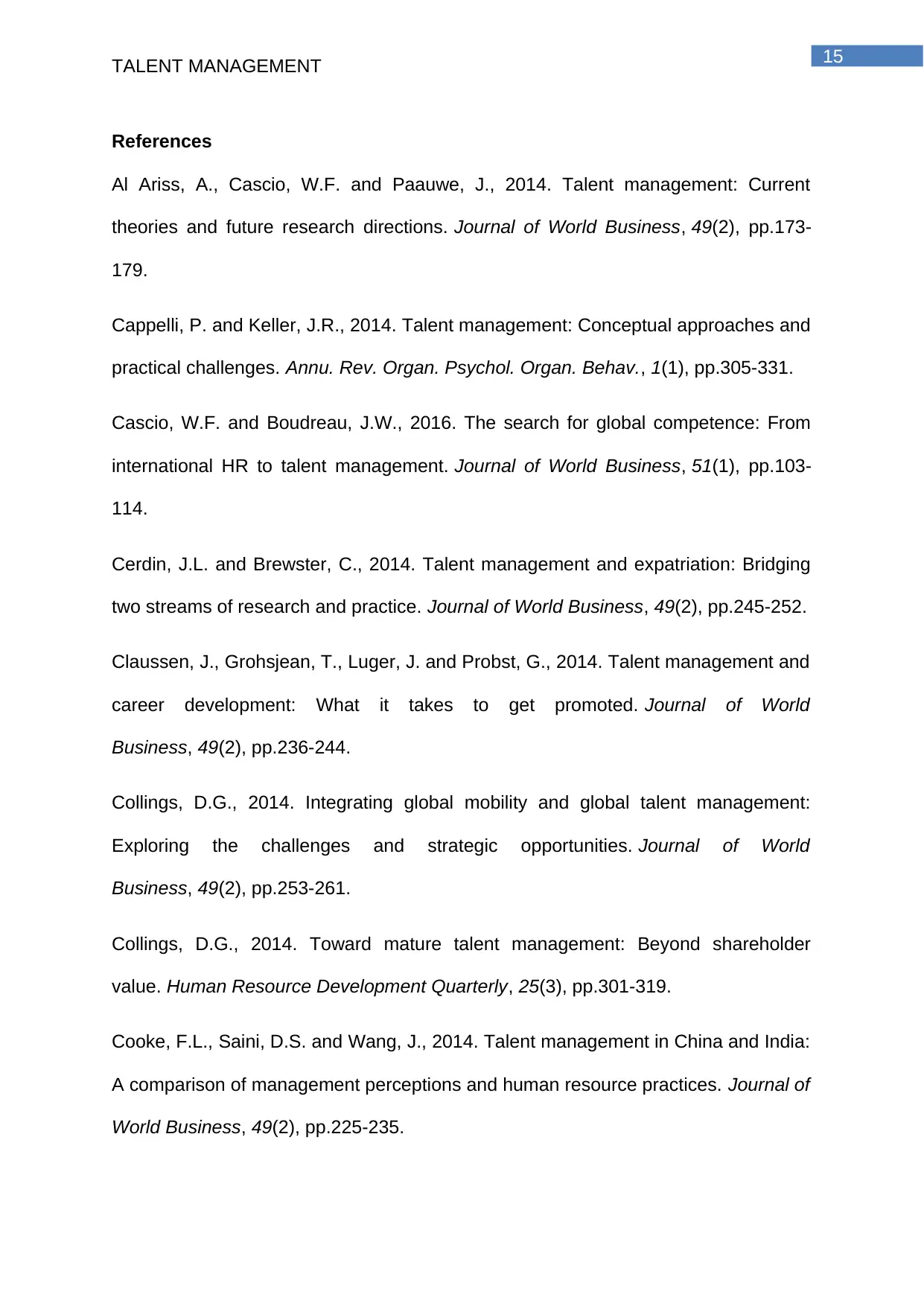
15
TALENT MANAGEMENT
References
Al Ariss, A., Cascio, W.F. and Paauwe, J., 2014. Talent management: Current
theories and future research directions. Journal of World Business, 49(2), pp.173-
179.
Cappelli, P. and Keller, J.R., 2014. Talent management: Conceptual approaches and
practical challenges. Annu. Rev. Organ. Psychol. Organ. Behav., 1(1), pp.305-331.
Cascio, W.F. and Boudreau, J.W., 2016. The search for global competence: From
international HR to talent management. Journal of World Business, 51(1), pp.103-
114.
Cerdin, J.L. and Brewster, C., 2014. Talent management and expatriation: Bridging
two streams of research and practice. Journal of World Business, 49(2), pp.245-252.
Claussen, J., Grohsjean, T., Luger, J. and Probst, G., 2014. Talent management and
career development: What it takes to get promoted. Journal of World
Business, 49(2), pp.236-244.
Collings, D.G., 2014. Integrating global mobility and global talent management:
Exploring the challenges and strategic opportunities. Journal of World
Business, 49(2), pp.253-261.
Collings, D.G., 2014. Toward mature talent management: Beyond shareholder
value. Human Resource Development Quarterly, 25(3), pp.301-319.
Cooke, F.L., Saini, D.S. and Wang, J., 2014. Talent management in China and India:
A comparison of management perceptions and human resource practices. Journal of
World Business, 49(2), pp.225-235.
TALENT MANAGEMENT
References
Al Ariss, A., Cascio, W.F. and Paauwe, J., 2014. Talent management: Current
theories and future research directions. Journal of World Business, 49(2), pp.173-
179.
Cappelli, P. and Keller, J.R., 2014. Talent management: Conceptual approaches and
practical challenges. Annu. Rev. Organ. Psychol. Organ. Behav., 1(1), pp.305-331.
Cascio, W.F. and Boudreau, J.W., 2016. The search for global competence: From
international HR to talent management. Journal of World Business, 51(1), pp.103-
114.
Cerdin, J.L. and Brewster, C., 2014. Talent management and expatriation: Bridging
two streams of research and practice. Journal of World Business, 49(2), pp.245-252.
Claussen, J., Grohsjean, T., Luger, J. and Probst, G., 2014. Talent management and
career development: What it takes to get promoted. Journal of World
Business, 49(2), pp.236-244.
Collings, D.G., 2014. Integrating global mobility and global talent management:
Exploring the challenges and strategic opportunities. Journal of World
Business, 49(2), pp.253-261.
Collings, D.G., 2014. Toward mature talent management: Beyond shareholder
value. Human Resource Development Quarterly, 25(3), pp.301-319.
Cooke, F.L., Saini, D.S. and Wang, J., 2014. Talent management in China and India:
A comparison of management perceptions and human resource practices. Journal of
World Business, 49(2), pp.225-235.
Secure Best Marks with AI Grader
Need help grading? Try our AI Grader for instant feedback on your assignments.
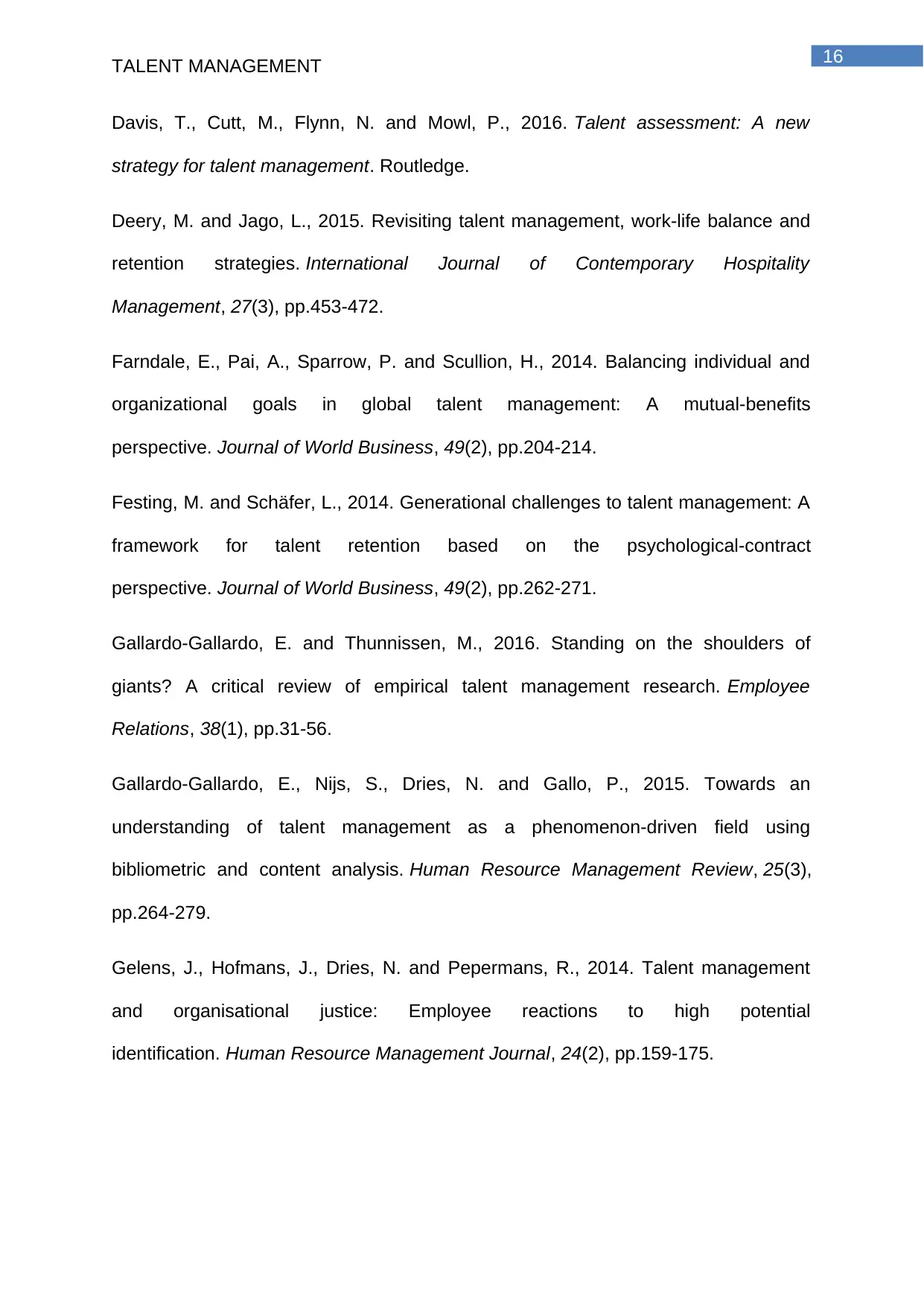
16
TALENT MANAGEMENT
Davis, T., Cutt, M., Flynn, N. and Mowl, P., 2016. Talent assessment: A new
strategy for talent management. Routledge.
Deery, M. and Jago, L., 2015. Revisiting talent management, work-life balance and
retention strategies. International Journal of Contemporary Hospitality
Management, 27(3), pp.453-472.
Farndale, E., Pai, A., Sparrow, P. and Scullion, H., 2014. Balancing individual and
organizational goals in global talent management: A mutual-benefits
perspective. Journal of World Business, 49(2), pp.204-214.
Festing, M. and Schäfer, L., 2014. Generational challenges to talent management: A
framework for talent retention based on the psychological-contract
perspective. Journal of World Business, 49(2), pp.262-271.
Gallardo-Gallardo, E. and Thunnissen, M., 2016. Standing on the shoulders of
giants? A critical review of empirical talent management research. Employee
Relations, 38(1), pp.31-56.
Gallardo-Gallardo, E., Nijs, S., Dries, N. and Gallo, P., 2015. Towards an
understanding of talent management as a phenomenon-driven field using
bibliometric and content analysis. Human Resource Management Review, 25(3),
pp.264-279.
Gelens, J., Hofmans, J., Dries, N. and Pepermans, R., 2014. Talent management
and organisational justice: Employee reactions to high potential
identification. Human Resource Management Journal, 24(2), pp.159-175.
TALENT MANAGEMENT
Davis, T., Cutt, M., Flynn, N. and Mowl, P., 2016. Talent assessment: A new
strategy for talent management. Routledge.
Deery, M. and Jago, L., 2015. Revisiting talent management, work-life balance and
retention strategies. International Journal of Contemporary Hospitality
Management, 27(3), pp.453-472.
Farndale, E., Pai, A., Sparrow, P. and Scullion, H., 2014. Balancing individual and
organizational goals in global talent management: A mutual-benefits
perspective. Journal of World Business, 49(2), pp.204-214.
Festing, M. and Schäfer, L., 2014. Generational challenges to talent management: A
framework for talent retention based on the psychological-contract
perspective. Journal of World Business, 49(2), pp.262-271.
Gallardo-Gallardo, E. and Thunnissen, M., 2016. Standing on the shoulders of
giants? A critical review of empirical talent management research. Employee
Relations, 38(1), pp.31-56.
Gallardo-Gallardo, E., Nijs, S., Dries, N. and Gallo, P., 2015. Towards an
understanding of talent management as a phenomenon-driven field using
bibliometric and content analysis. Human Resource Management Review, 25(3),
pp.264-279.
Gelens, J., Hofmans, J., Dries, N. and Pepermans, R., 2014. Talent management
and organisational justice: Employee reactions to high potential
identification. Human Resource Management Journal, 24(2), pp.159-175.
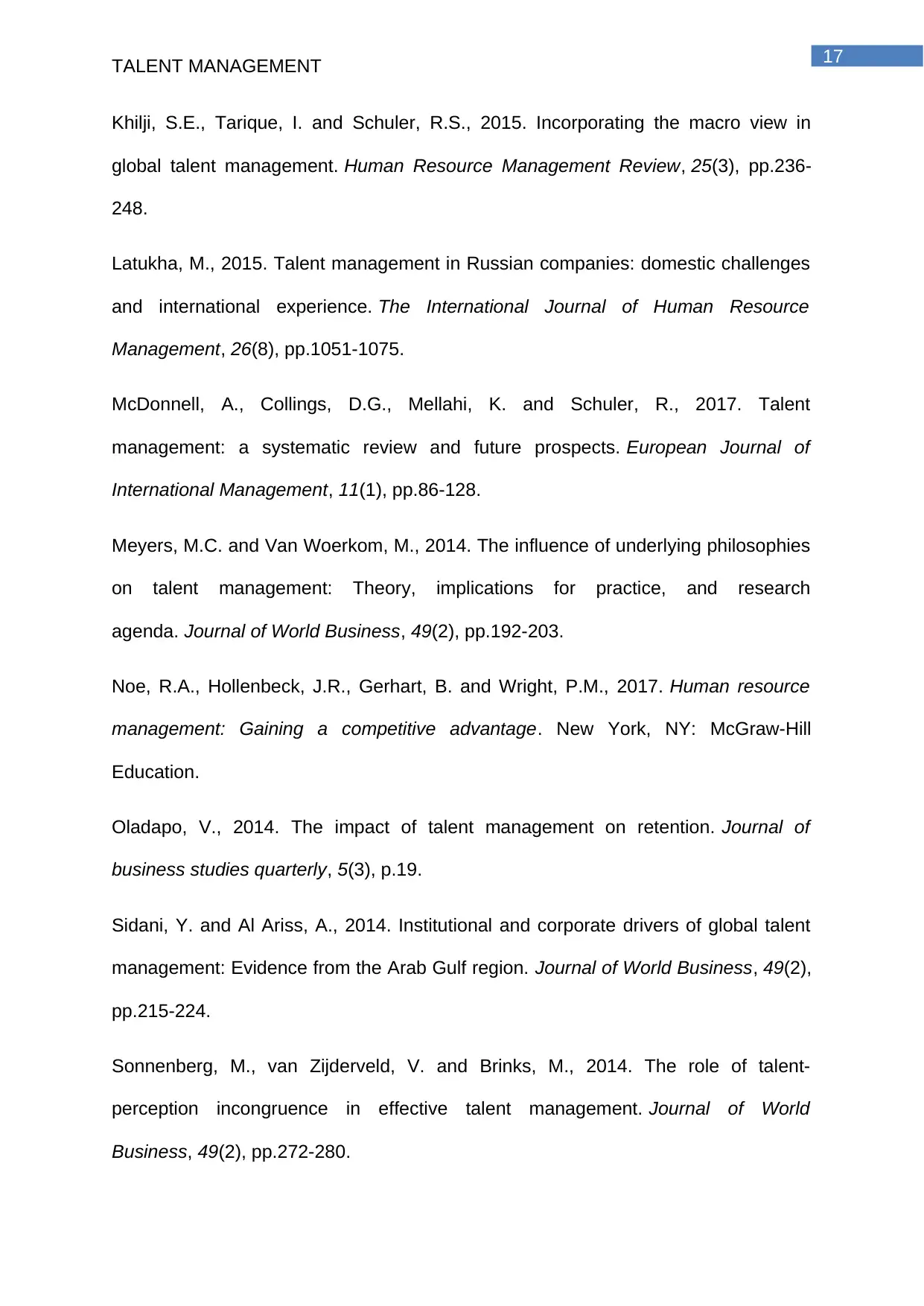
17
TALENT MANAGEMENT
Khilji, S.E., Tarique, I. and Schuler, R.S., 2015. Incorporating the macro view in
global talent management. Human Resource Management Review, 25(3), pp.236-
248.
Latukha, M., 2015. Talent management in Russian companies: domestic challenges
and international experience. The International Journal of Human Resource
Management, 26(8), pp.1051-1075.
McDonnell, A., Collings, D.G., Mellahi, K. and Schuler, R., 2017. Talent
management: a systematic review and future prospects. European Journal of
International Management, 11(1), pp.86-128.
Meyers, M.C. and Van Woerkom, M., 2014. The influence of underlying philosophies
on talent management: Theory, implications for practice, and research
agenda. Journal of World Business, 49(2), pp.192-203.
Noe, R.A., Hollenbeck, J.R., Gerhart, B. and Wright, P.M., 2017. Human resource
management: Gaining a competitive advantage. New York, NY: McGraw-Hill
Education.
Oladapo, V., 2014. The impact of talent management on retention. Journal of
business studies quarterly, 5(3), p.19.
Sidani, Y. and Al Ariss, A., 2014. Institutional and corporate drivers of global talent
management: Evidence from the Arab Gulf region. Journal of World Business, 49(2),
pp.215-224.
Sonnenberg, M., van Zijderveld, V. and Brinks, M., 2014. The role of talent-
perception incongruence in effective talent management. Journal of World
Business, 49(2), pp.272-280.
TALENT MANAGEMENT
Khilji, S.E., Tarique, I. and Schuler, R.S., 2015. Incorporating the macro view in
global talent management. Human Resource Management Review, 25(3), pp.236-
248.
Latukha, M., 2015. Talent management in Russian companies: domestic challenges
and international experience. The International Journal of Human Resource
Management, 26(8), pp.1051-1075.
McDonnell, A., Collings, D.G., Mellahi, K. and Schuler, R., 2017. Talent
management: a systematic review and future prospects. European Journal of
International Management, 11(1), pp.86-128.
Meyers, M.C. and Van Woerkom, M., 2014. The influence of underlying philosophies
on talent management: Theory, implications for practice, and research
agenda. Journal of World Business, 49(2), pp.192-203.
Noe, R.A., Hollenbeck, J.R., Gerhart, B. and Wright, P.M., 2017. Human resource
management: Gaining a competitive advantage. New York, NY: McGraw-Hill
Education.
Oladapo, V., 2014. The impact of talent management on retention. Journal of
business studies quarterly, 5(3), p.19.
Sidani, Y. and Al Ariss, A., 2014. Institutional and corporate drivers of global talent
management: Evidence from the Arab Gulf region. Journal of World Business, 49(2),
pp.215-224.
Sonnenberg, M., van Zijderveld, V. and Brinks, M., 2014. The role of talent-
perception incongruence in effective talent management. Journal of World
Business, 49(2), pp.272-280.
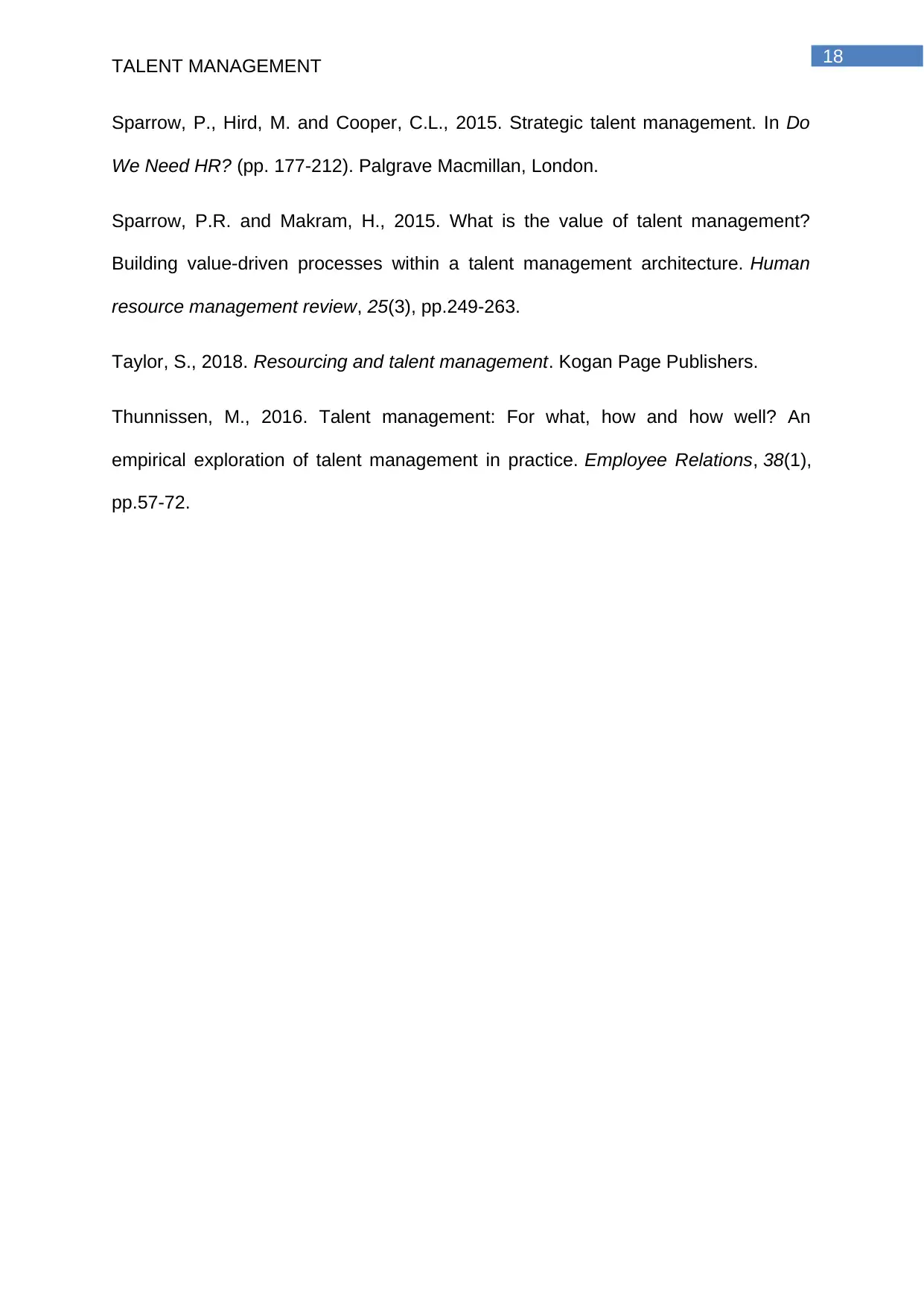
18
TALENT MANAGEMENT
Sparrow, P., Hird, M. and Cooper, C.L., 2015. Strategic talent management. In Do
We Need HR? (pp. 177-212). Palgrave Macmillan, London.
Sparrow, P.R. and Makram, H., 2015. What is the value of talent management?
Building value-driven processes within a talent management architecture. Human
resource management review, 25(3), pp.249-263.
Taylor, S., 2018. Resourcing and talent management. Kogan Page Publishers.
Thunnissen, M., 2016. Talent management: For what, how and how well? An
empirical exploration of talent management in practice. Employee Relations, 38(1),
pp.57-72.
TALENT MANAGEMENT
Sparrow, P., Hird, M. and Cooper, C.L., 2015. Strategic talent management. In Do
We Need HR? (pp. 177-212). Palgrave Macmillan, London.
Sparrow, P.R. and Makram, H., 2015. What is the value of talent management?
Building value-driven processes within a talent management architecture. Human
resource management review, 25(3), pp.249-263.
Taylor, S., 2018. Resourcing and talent management. Kogan Page Publishers.
Thunnissen, M., 2016. Talent management: For what, how and how well? An
empirical exploration of talent management in practice. Employee Relations, 38(1),
pp.57-72.
1 out of 19
Related Documents
Your All-in-One AI-Powered Toolkit for Academic Success.
+13062052269
info@desklib.com
Available 24*7 on WhatsApp / Email
![[object Object]](/_next/static/media/star-bottom.7253800d.svg)
Unlock your academic potential
© 2024 | Zucol Services PVT LTD | All rights reserved.





